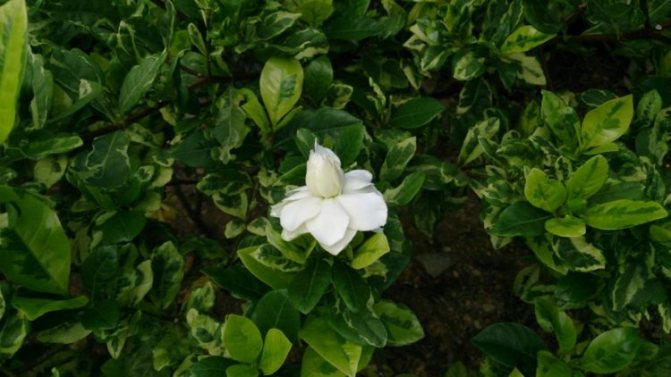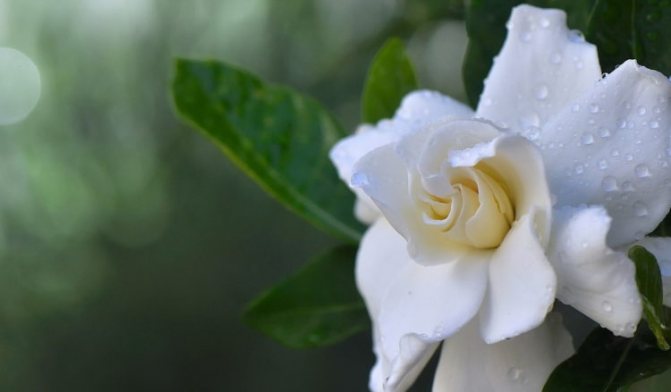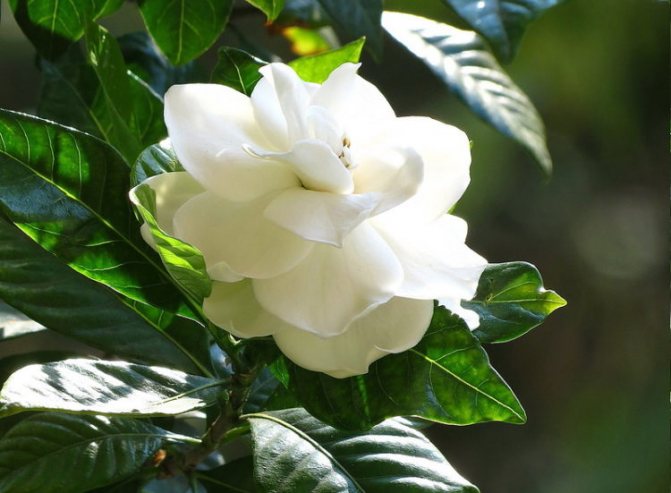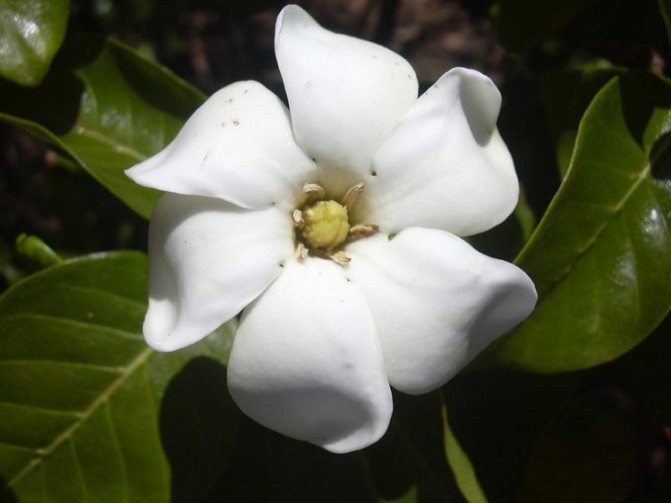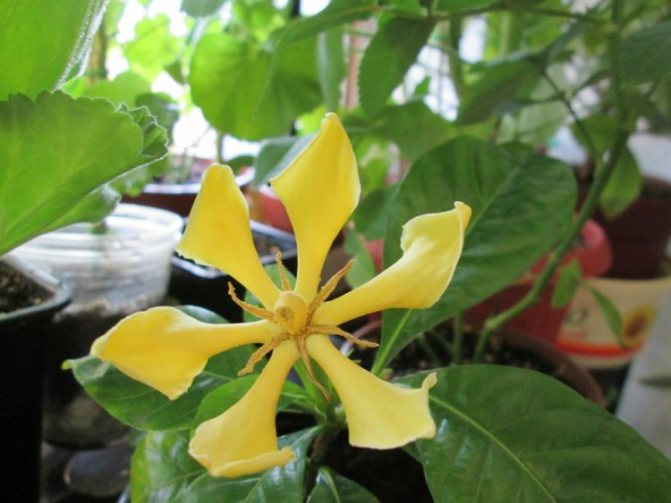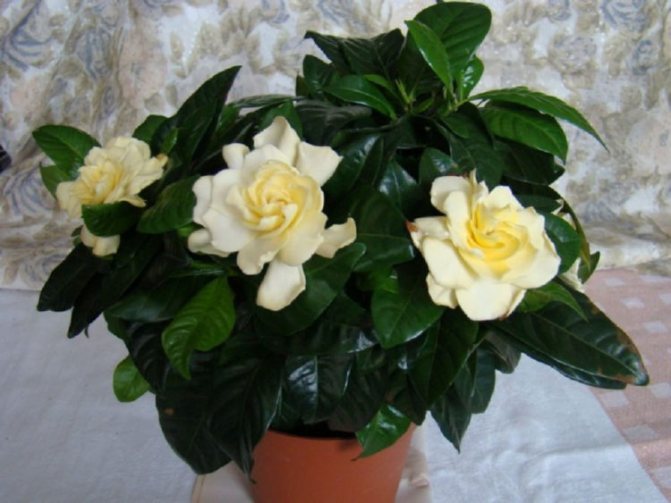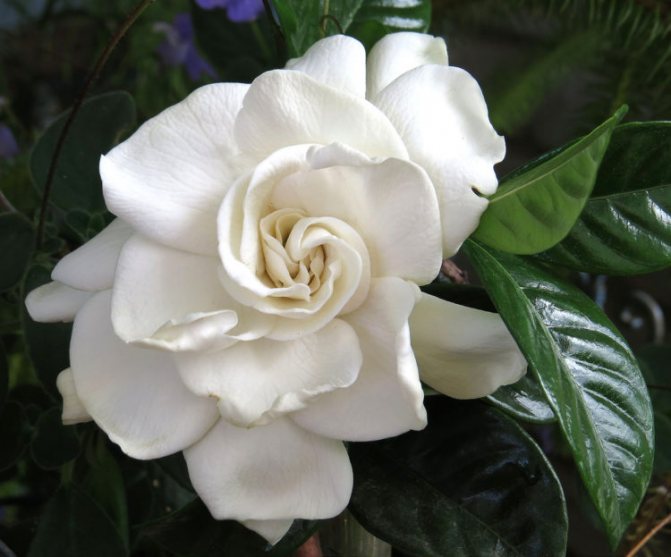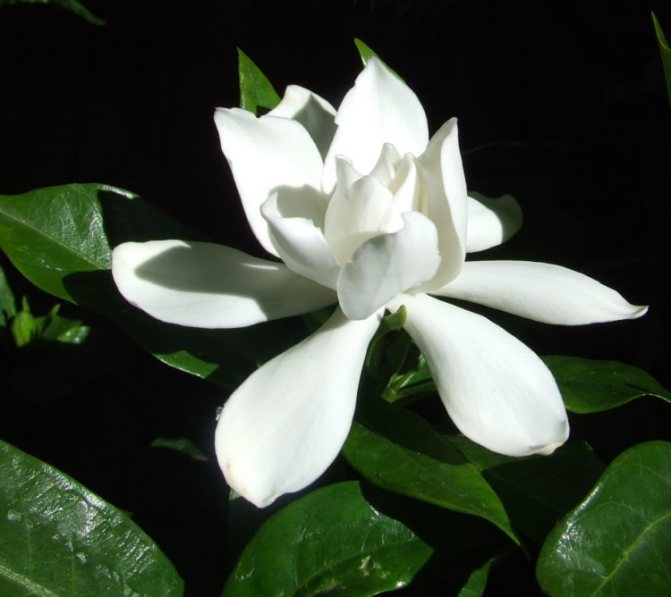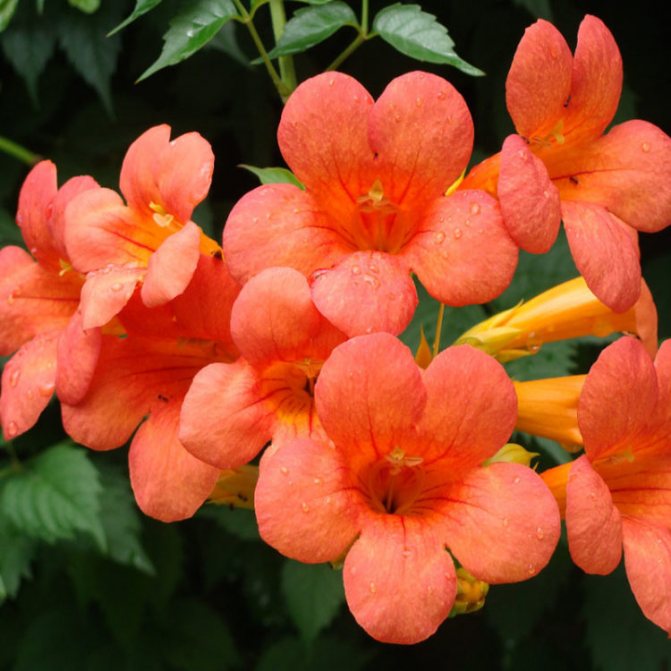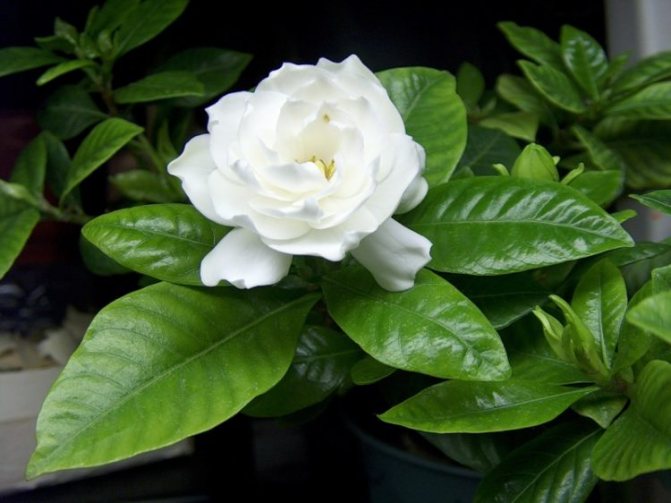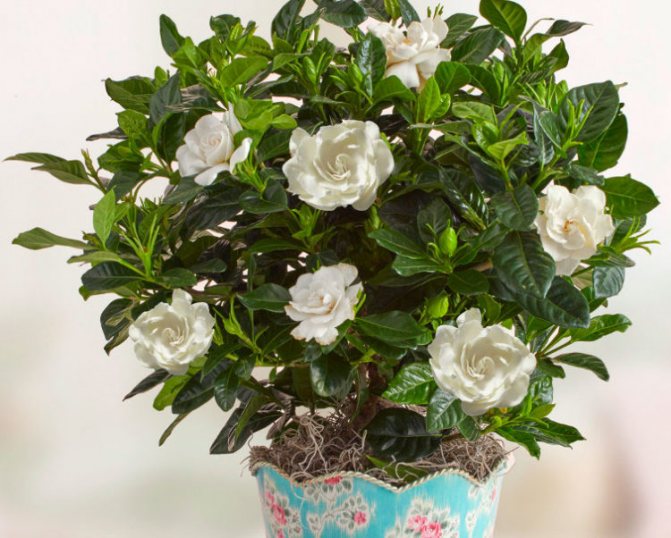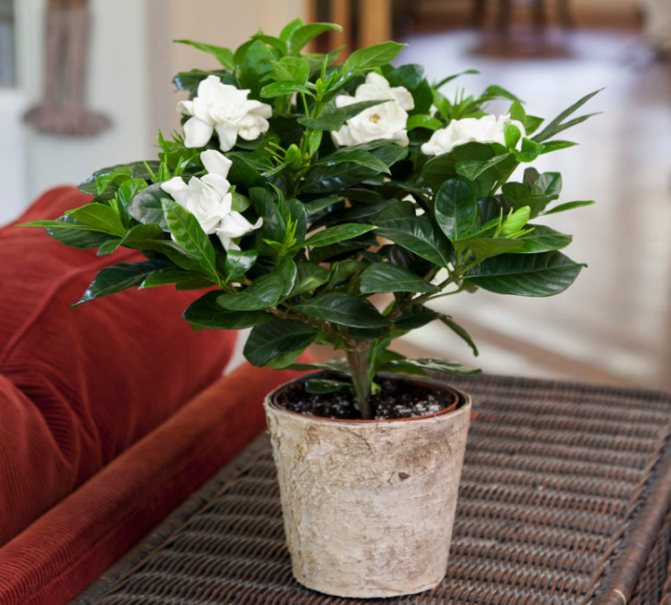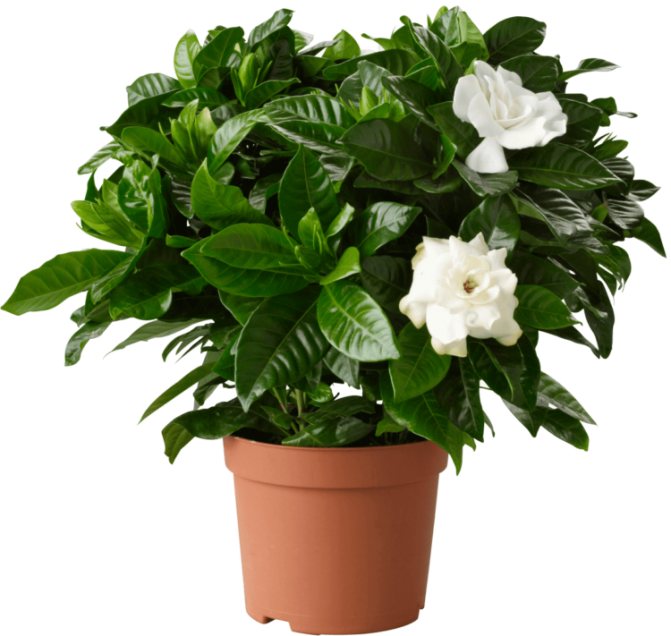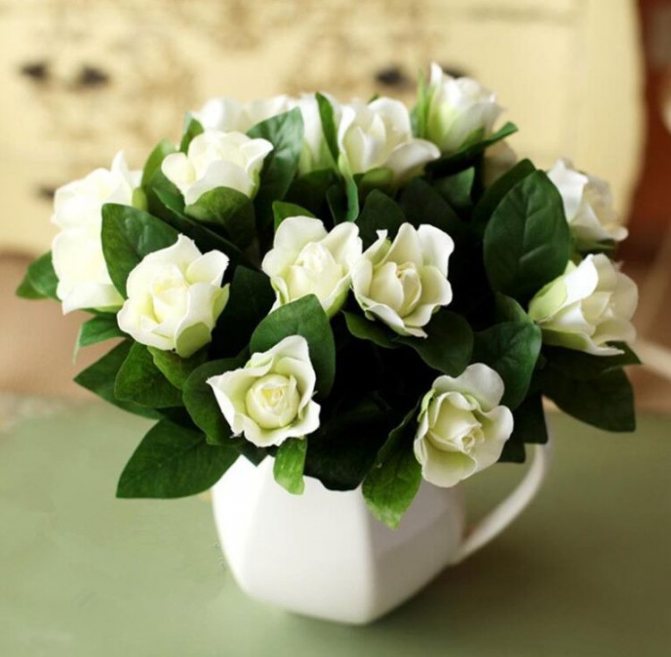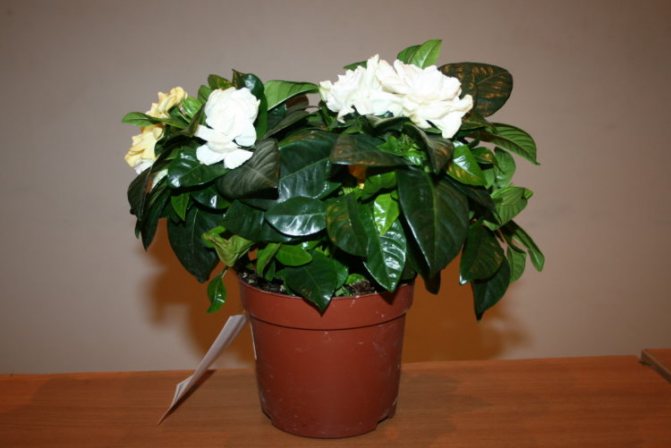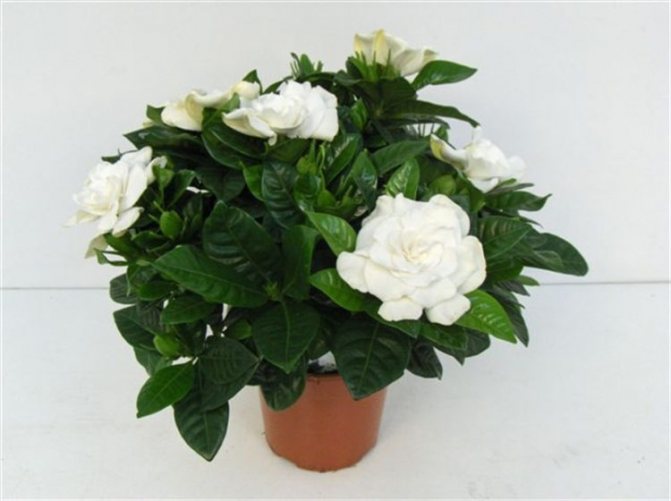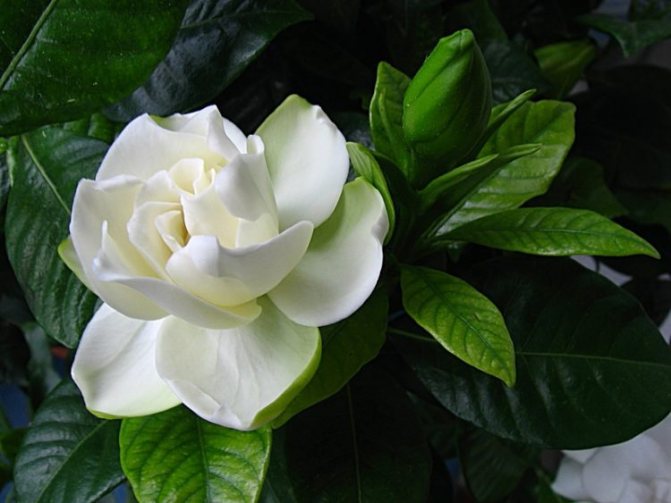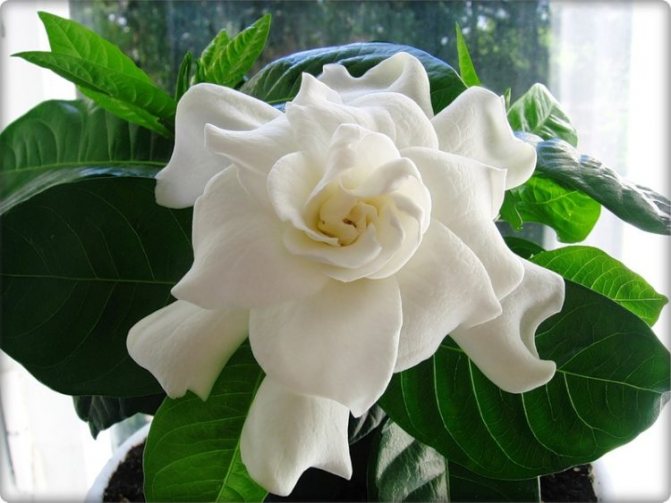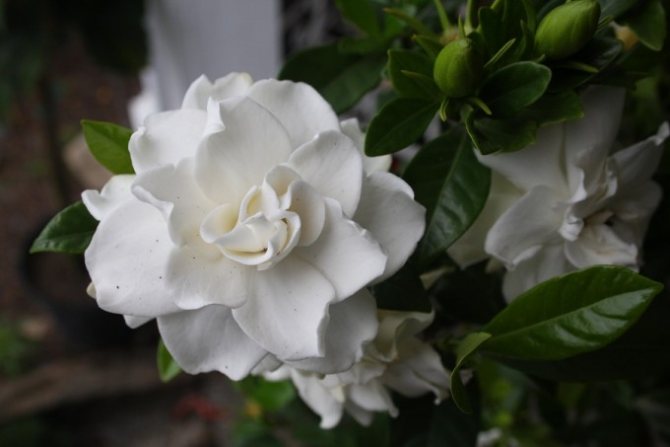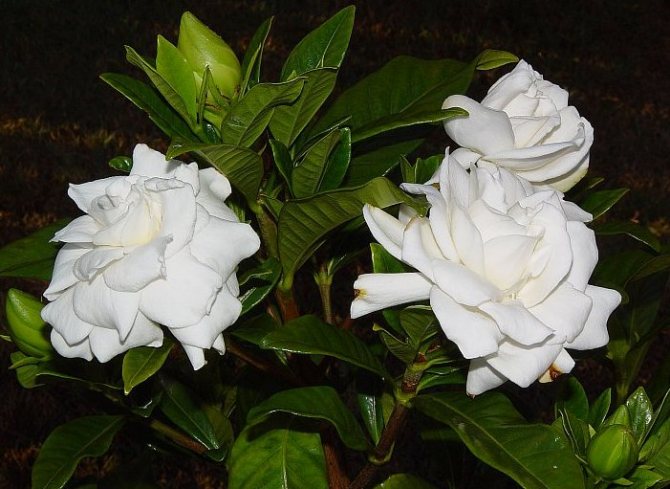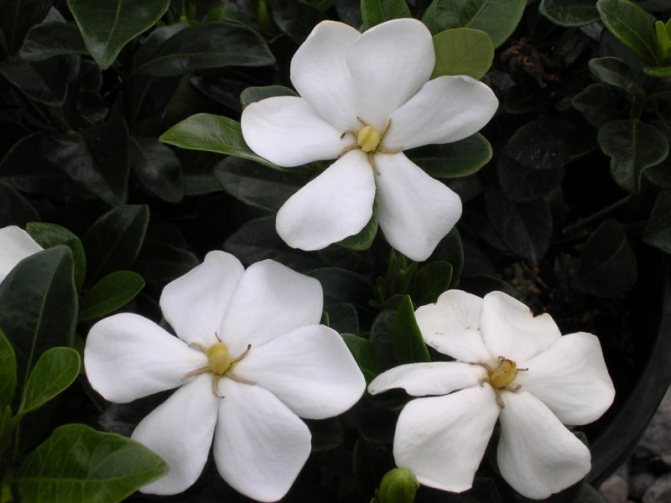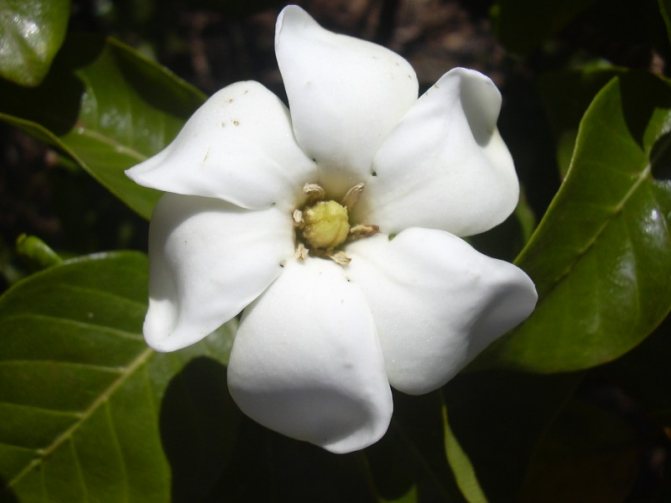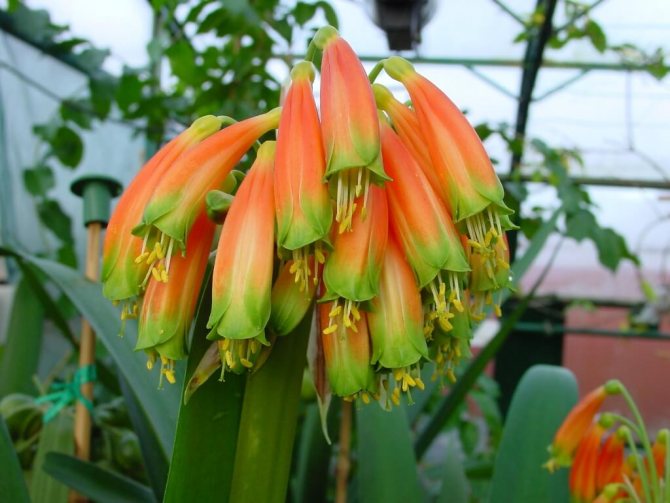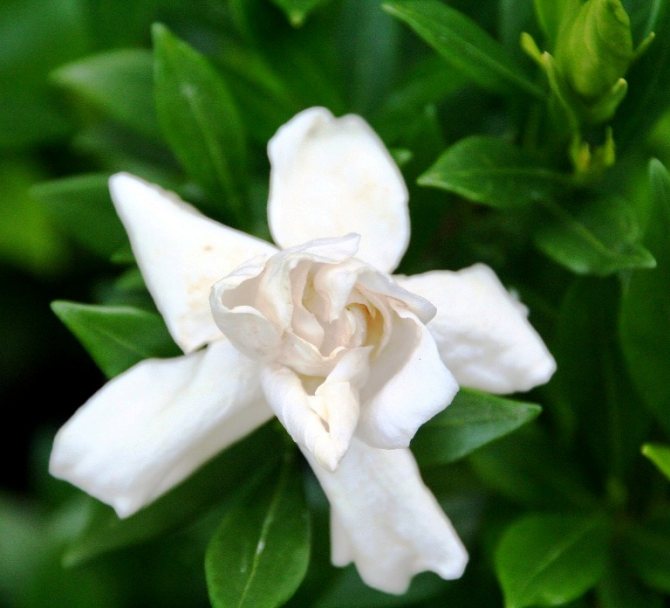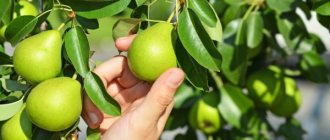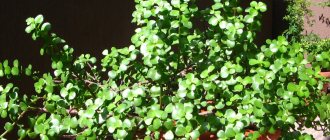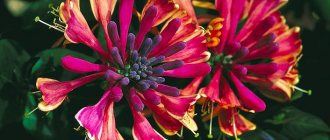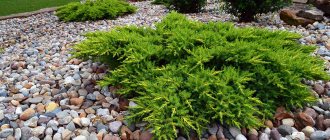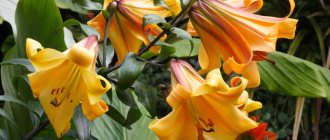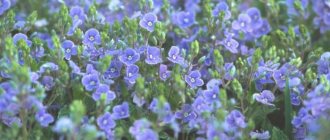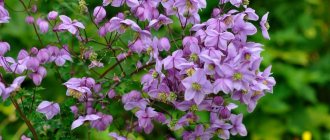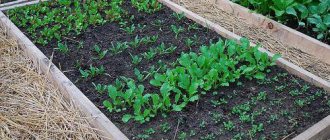Category: Houseplants
Gardenia (lat.Gardenia) - a genus of the Madder family from the tropics, which is named after the American physician and naturalist Alexander Garden. In indoor conditions, the gardenia flower does not take up much space, but in nature - in East and Southeast Asia, as well as in South Africa - the gardenia plant sometimes reaches two meters in height. Gardenia, grown at home - jasmine, sometimes called by flower growers "Japanese beauty", she came to England in 1760.
Florists grow it not only for the sake of beautiful white, like waxy, flowers emitting a delicate scent of jasmine, but also for the glossy leaves of a rich dark green color, which are a worthy decoration for a gardenia when it is not in bloom.
general description
In the wild, gardenia is an evergreen shrub that can sometimes be tree-like. Belongs to the Marenov family. Grows in tropical and subtropical forests of China, India, Indonesia, found in Japan. It is a compact shrub with a smooth stem and short branches with leathery shiny leaves of a rich green color.
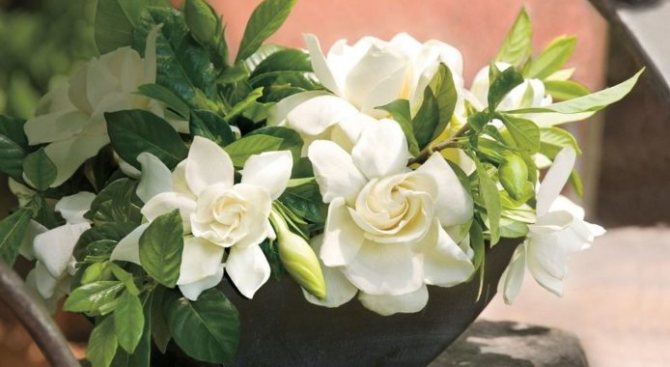
Flowering is long, begins in mid-summer and ends in October. With proper planting and proper care during this period, its shoots are completely covered with numerous flowers in varying degrees of budding. Outwardly, they have a resemblance to roses, she will not yield to the queen of flowers in a delicate pleasant aroma. The graceful appearance allows the gardenia to be used in the design of interior solutions of a wide variety of styles.
The closest relative of this tropical flower is coffee.
Indoor plant description
Gardenia is an evergreen shrub that belongs to the Marenov family. The homeland of the plant remains the tropics of Africa and Asia. Under natural conditions, the height of the bush reaches 1.5 m. The leaves are oval in shape, the tips are pointed. The leaf plate itself is dense, leathery, glossy. Its length is 10 cm.
The flowers are large, 7-10 cm in diameter, the color is white or cream. Very fragrant and rose-like in shape. Flowers can be double or simple. Flowering lasts throughout the summer and half of autumn. After that, the fruits begin to ripen - berries.
Types of gardenia with photos
Botanists describe about 250 varieties, among which Gardenia jasminoides, native to the southern provinces of China, is the most acceptable for home cultivation. The second, almost unused species name is the gardenia of Augusta. Its twin inflorescences are similar to camellia. Attempts to grow at home and the African variety of gardenia tunbergia (Gardenia thunbergia), which is distinguished by single inflorescences. You should know that the second type is more whimsical. In addition, knowledge about how to care for a gardenia is not enough without meeting a number of subjective conditions (for example, the absence of windows of the desired orientation or their shading by trees).
As a result of the long cultivation of the jasmine variety, many varieties have appeared, from which the most popular and suitable for growing in rooms and greenhouses can be distinguished.
- Beauty - a tall variety with large double waxy flowers that bloom throughout the summer season until the last days of October. In greenhouses, it can reach a height of 2 meters.
- Chuck Hkys - semi-double, very fragrant with ivory flowers. Summer bloom, rather short. Differs in increased resistance to cold.
- Amy - stands out with a lighter color of foliage. The flowers are terry, have an almost perfect shape, which makes them look like artificial ones. It is highly regarded for its ability to bloom twice a year.
- Mystery - a tall, large-flowered variety with very dark leaves. Terry inflorescences are flat, up to 13 cm in diameter. Forms a very strong shrub with a vertical tendency. It can also bloom again.
- Belmond - large-flowered and densely double, has a high tolerance to temperature drops and diseases. The diameter of the inflorescences with an amazing aroma reaches 10 cm.
- Variegata - a slow-growing compact shrub with rounded variegated leaves that have transitions from green to light beige. A good option for pot growing at home.
- Radikans - a dwarf varietal line, which is ideal for bonsai. The crown width exceeds its height. The leaves are small, leathery, with a waxy sheen, double flowers, medium-sized. Flowering occurs later than other varieties of jasmine gardenia.
- Radikan Variegata - a variety bred on the basis of the previous one with more grown characteristics. It grows extremely slowly making it an excellent candidate for bonsai, the green leaves have a light cream streak along the edge. Flowering is late, short, in summer.
- Golden Magic - white corollas of inflorescences have a characteristic transition to a golden yellow color. It blooms effectively and long-term.
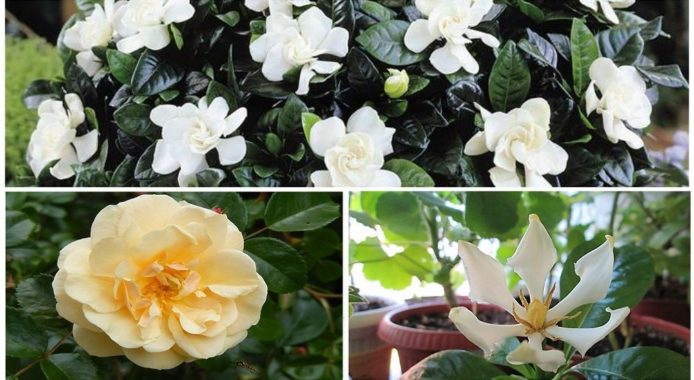

Temperature
This thermophilic tropical plant requires high air temperatures in summer and winter. In the warm period, it is kept at 22-24 ° C, and in winter - at 18-20 ° C.
Even in the coldest period, the temperature should not be lower than 16 ° C... The plant does not tolerate sudden changes in temperature.
Gardenia tolerates heat only with abundant watering and high humidity. When the air temperature rises to 30 ° C, the plant can discard the formed buds and flowers.
In winter, it is useful to lower the temperature of the flower keeping a little. Wintering at a temperature of 16-18 ° C will provide abundant flowering in the summer.
On the contrary, if the winter temperature is in the range of 22-24 ° C, abundant flowering cannot be expected. The plant should be protected from cold drafts, the movement of air near the plant should be minimal.
Features of buying a gardenia
Despite the increased demand of the flower for warmth, now you can buy it all year round, although in winter it is certainly more difficult to do this. The sold copies have a pronounced division into "estates" according to the category of their cost from manufacturers. The most expensive pieces are put up for sale in the bud stage, which requires assistance to open. This should be done under a warm, but not hot shower.
Moving a gardenia into the house (or to any other place) is much more stressful for her than for many other plants, so many specimens die already at this stage. According to gardeners, drugs such as Epin, Zircon or HB101 can help her survive stress. The dosage and frequency must be observed according to the attached instructions.
In expensive specimens, the inner petals are often neatly sealed with wax, which requires the same careful removal. The top of the buds may have supporting collars of leaves. In cheaper varieties (or producers), the buds are usually smaller and more open, they are often wearing plastic collars.
When buying a gardenia as a gift, you should think very carefully about whether the person being gifted will be able to cope with this flower and provide him with the care he needs. Otherwise, only disappointments will remain from the gift.
Pinching and pruning gardenia
- They begin to pinch gardenia from the second year of life.
- To do this, cut the tops of the shoots over the third pair of leaves with scissors in order to increase the branching and splendor of the crown.
- Pruning is necessary when removing dry, ugly twigs and when forming the correct crown shape.
- Thickening branches that grow unevenly are cut off, too long are shortened.
- Faded flowers and dried buds are also cut off.
Gardenia pruning tolerates well, quickly expelling new shoots instead of old ones.
How to form a gardenia bush, look at the video:
It is important not to be afraid to prune in a timely manner so that the bush develops evenly and remains well-groomed. The compact form of the bush is maintained by constant pinching of the tops of the left shoots and pruning of branches at least once a year.
Gardenia bonsai
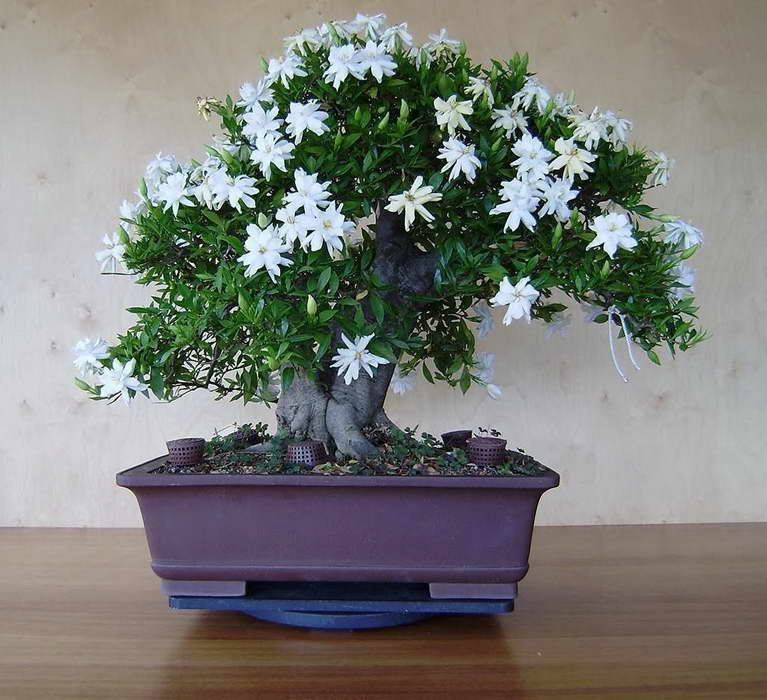

Gardenia bonsai photo
- The plant can be formed in a bonsai style.
- For this, a central shoot is formed, constantly pinching all the tops and cutting out excess branches.
- The trunk of the plant will become thicker every year, and the branches will be rejuvenated by cardinal pruning.
- It is important to prune before the end of autumn so that flower buds have time to start. Then the gardenia will annually delight you with incomparable flowering on a mini bonsai-style tree.
Indoor gardenia care
Each item of the requirements for agricultural technology is in this case important and requires strict implementation.
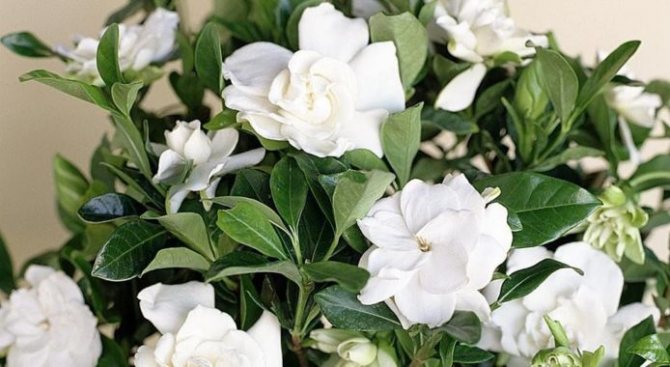

Lighting
The flower loves full lighting throughout the day, but it does not respond well to direct midday rays. Ideal would be a very bright, but not hot place on a window facing west or southwest, on which a thin tracing paper is glued to protect from the direct sun at noon. In winter, the tracing paper can be removed. The window must not be shaded by the trees behind it.
Gardenia is extremely sensitive not only to the intensity of illumination, but also to its directionality. During the period of budding and flowering, it can not only be rearranged to another place, but even rotated relative to the light source. The buds may fall off.
Temperature regime
Love of a flower in warmth does not mean that it needs to be kept in a hot room. There is a certain range of comfort, which directly depends on the season and the stage of vegetative development. In the spring-summer period, the optimum temperature is within + 20 ... + 24C. In winter, it should be gradually reduced by 4-5C relative to summer. The minimum temperature threshold is + 16C. During the budding period, it rises to + 18 ... + 20C. In any layout, roots should never be in cold soil (colder than indoor air). Sharp fluctuations in temperature readings are especially dangerous for the culture. In winter, the plant experiences a lack of light, and cooler conditions can partially compensate for this.
Gardenia categorically does not tolerate drafts, reacting to them by dumping buds and buds. It is better to ventilate the room with forced ventilation directed to the other side.
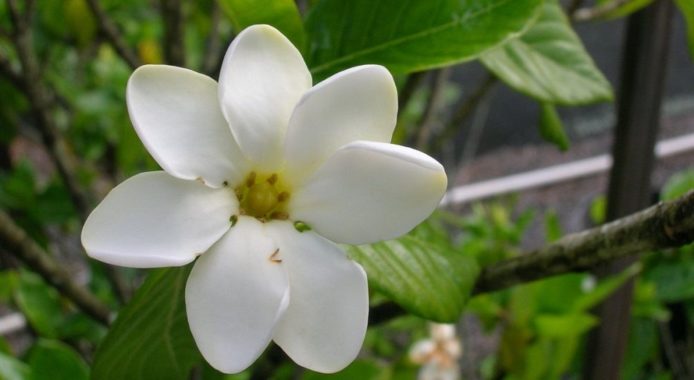

Air humidity
High and uniform air humidity is one of the conditions for the successful development and flowering of a plant. It makes especially high demands on humidity during the budding period. In dry air, the process may stop developing, and the buds that have begun to form may fall off. A pallet filled with sphagnum or moistened expanded clay will help solve the problem, but the flower pot itself should not touch their bottom. Regular spraying of the foliage is recommended, however, the water should not get on the flowers or unopened buds (ugly spots may appear).
Watering
For irrigation, use warm and soft water, it is desirable that it be settled, boiled or filtered. In summer, watering should be stable to keep the soil moderately moist. Overflow is highly undesirable. The plant loves a warm shower, but during this time you need to close the earthen lump.During the winter season, watering is reduced to restrained moderate, but the earthen ball should never be overdried.
Top dressing
It is necessary to provide additional nutrition during the period of active vegetation and flowering, in spring and summer (1-2 times a month). Use liquid complex dressings for flowering crops, but at half the dosage recommended in the instructions.
Pruning
The culture not only tolerates pruning well, but also periodically needs it. Cut off the shoots after flowering, leaving half or a third of them. During the period of active growth, you can pinch the tops of non-flowering shoots to stimulate the growth of new ones.
The trimmed parts of the stems can be used as apical cuttings for propagation.
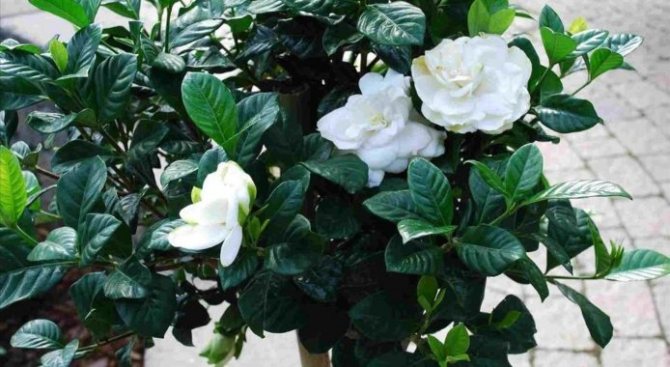

Features of growing gardenia: tips for beginners
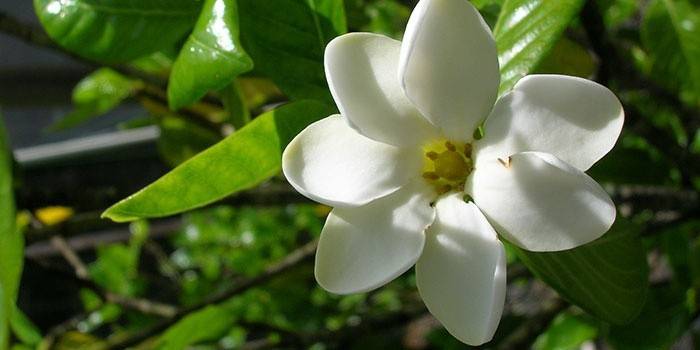

Gardenia jasmine loves frequent spraying, so this procedure is worth carrying out several times a day. Otherwise, its juicy leaves will begin to lose their attractiveness, and the buds will begin to die off (in this case, they must be cut off immediately). Caring for a gardenia is considered a problematic occupation, since it is extremely difficult to achieve its flowering, especially for novice growers. If you do not follow all the rules for caring for the plant, then not only will you not wait for the buds to fall out, but you can even destroy the gardenia. To avoid this:
- Do not place the flower pot in the water pan.
- During winter (dormant time) water the plant sparingly. This will allow for good flowering.
- In the spring, start shaping the crown.
- Protect the flower from drafts or sudden changes in temperature.
- Use a leaf sprayer carefully, do not let water get on the buds, otherwise they will darken and fall off.
What kind of land does a gardenia need?
Calcareous and alkaline soils are not suitable for her, high acidity values from pH = 5 and slightly higher are needed. When transplanting a gardenia after purchase, you should try to preserve its soil ball as much as possible, for adding to which it is recommended to buy a ready-made substrate for azaleas. It's better not to experiment with making your own potting mix for a start. With later transplants, you can add a composition of equal parts of three types of soil (coniferous, sod, leaf) and quartz sand.
Why gardenia does not bloom - reasons
- Lack of lighting. The best place for keeping gardenia dmoa is in the eastern windows, where the sun comes in the morning. The south side is too hot for a flower, the active midday sun will burn the leaves. On the northern windows, the plant will grow passively. If the flower does not have enough light in winter, install special additional lamps.
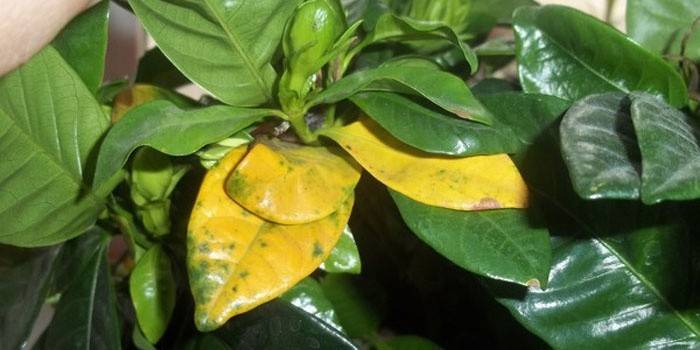

- Poor temperature conditions. Gardenia can only bloom at temperatures between 18 and 25 degrees, otherwise the buds will not even open.
- Dry air. If the plant is not properly hydrated, it can become naughty. Steam baths are considered to be an effective method of stimulating the flowering of home gardenias. To do this, bring the flower into the bathroom, turn on hot water and leave the tub to fill up to the brim. Leave the plant to bask in high humidity conditions for several hours. If possible, repeat the procedure weekly until the buds open.
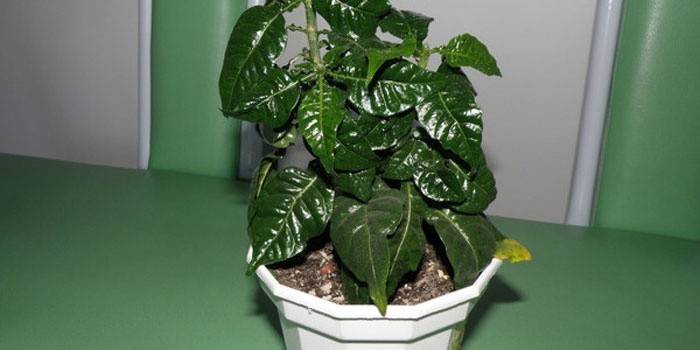

- Lack of recharge. For a home gardenia to bloom, it must receive the right ingredients. The main trace elements for her are magnesium, phosphorus, potassium and iron. To care for the plant, choose a fertilizer that contains the maximum amount of the listed substances, and you will soon see beautiful flowers on the stems. You can use such effective drugs as "Domotsvet", "Bud", "Zircon".
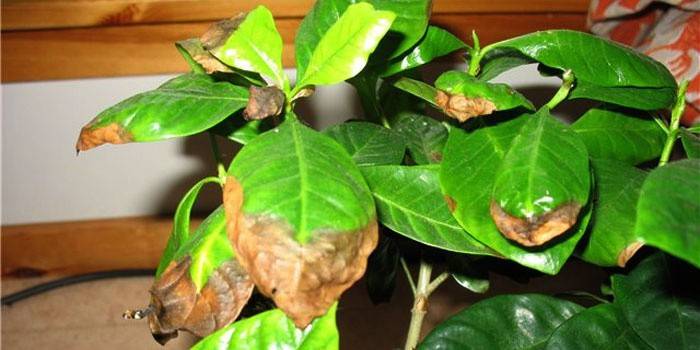

- Alkaline soil. At home, gardenia can bloom exclusively in acidic soil. Neutral or alkaline earth is not good for her.Proper plant care is to constantly maintain the acidity of the soil by acidifying the irrigation water.
Planned transplant
The frequency of a planned transplant is usually two years. The new container should be 2 cm wider than the previous one. In order to painlessly and correctly transplant the gardenia, you need to handle its root system as carefully as possible, preserving the earthen lump. This is done in early spring before the start of active vegetation and the release of buds. During flowering, transplanting is strongly discouraged and can only be justified by the threat of death. The flower will not only shed its buds, but may also die. Good drainage must be provided!
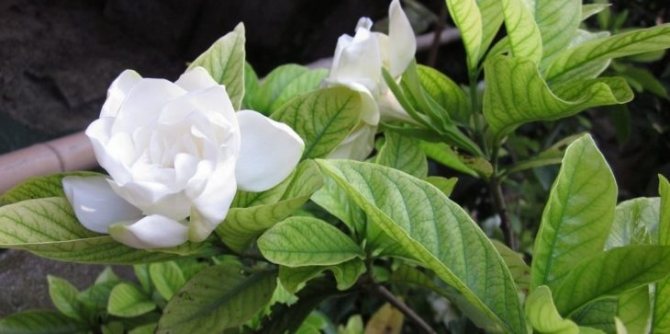

Photo
Next, we show a gardenia flower in the photo.
Reproduction
As a result of planned pruning, an excellent material for vegetative propagation remains - apical cuttings. They should be about 10 cm long. For their rooting, use a warm nutrient substrate (see above) and any rooting stimulant. Arranging a mini-label with a jar or a transparent bag will speed up the process. It is permissible to keep the cuttings in water, but in this case they may not give roots. After the cutting has doubled its height, it is pinched. You need to be prepared for the fact that the process will be lengthy and not always successful.
Reproduction of gardenia at home
Gardenia from seed
Growing a gardenia from seed is not the best way to propagate a plant. Only freshly harvested seeds are suitable for reproduction, since they quickly lose their germination. Before planting in the soil for azaleas, the seeds must be soaked for 2-3 hours in Zircon or aloe juice - stimulants, then sow the seeds on the ground and sprinkle on top through a sieve with the same mixture with a layer of 0.5 cm, water carefully, cover the container with seeds with film or glass and keep warm, airing from time to time for 1-2 hours. Seedlings will appear not earlier than in a month. If seedlings appear in the autumn-winter time, they will have to be artificially illuminated.
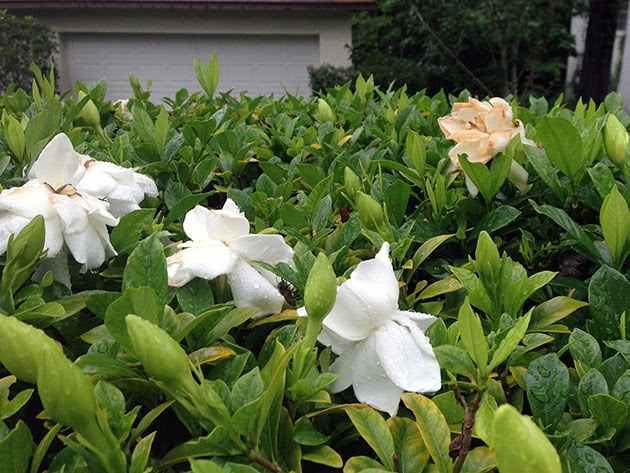

Reproduction of gardenia by cuttings
When the gardenia has faded, it is usually trimmed two-thirds of the length of the shoots, removing weak shoots and thinning if the bush becomes too thick. During the growth period, too, from time to time you have to pinch one or the other shoot, stimulating tillering. These cuttings are the material for the propagation of gardenia - apical and semi-lignified. The length of the shoot should be about 10 cm. The substrate for the cuttings is a mixture of river sand and peat 1: 1. Soak the cuttings in a pale pink solution of potassium permanganate for half an hour, plant them in the ground and cover with glass or film to ensure a greenhouse effect.
The temperature should be 25 ºC, the cuttings should be regularly ventilated and the soil should be moistened. You can accelerate root formation by arranging the lower heating for the cuttings. When the cuttings are rooted, they are transplanted into soil for azaleas or adult gardenias, and when they reach a height of 15 cm, pinched to stimulate the emergence of side shoots. When the lateral shoots grow 10-12 cm in height, they are also pinched. When the young gardenia becomes a bush, it is transferred to a larger pot.
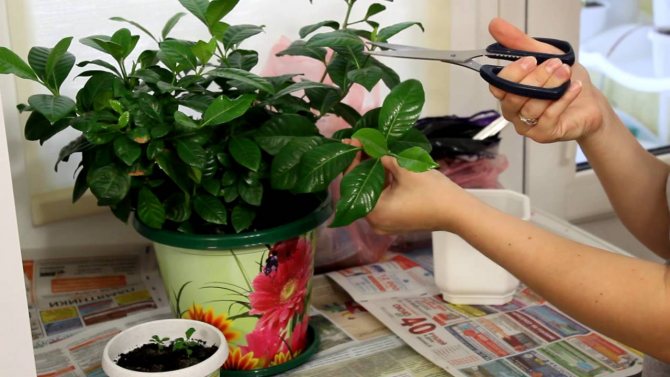

Possible problems
- Very slow development, no flowering, pale foliage. The flower lacks food and light.
- Gardenia leaves turn yellow or become covered with yellow stains. There is not enough acidity in the soil, the soil must be acidified.
- The flower wilts, loses buds, leaves become lethargic. It is necessary to control the temperature regime, most likely it is below normal.
- Leaves fall, while sometimes remaining green. Cold water for irrigation, lack of moisture.
- The gardenia dries up. Various adverse factors can occur, the most common being dry air, lack of moisture.
- Discharge of buds and flowers. Drafts or moving the pot from place to place, a sharp change in the intensity of lighting.
Problems and illnesses
In gardenia, all diseases arise from improper care. or infestation with pests. This could be:
- shield;
- aphid;
- thrips;
- mealybug;
- spider mite;
- nematode;
- whitefly.
When pests infect a gardenia, the shoots lose their shape, and the following appear on the leaves:
- holes;
- incomprehensible points;
- whitish or black bloom.
You can get rid of some pests with the help of insecticidal preparations. And from others, washing the leaves with a solution of potash or laundry soap will help.
If dry foliage appears on the plant, then the reason may be:
- broken watering system;
- incorrectly performed transplant;
- unsuitable soil.
Buds can fall off from:
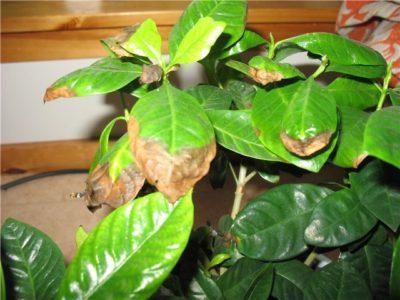

excess moisture;- hypothermia of the flower;
- low air humidity;
- moving the flowerpot during the flowering period.
When white spots appear on the leaf plates of gardenia, this indicates the development of chlorosis. If the leaves turn black and fly around, then most likely the roots are heavily flooded with water or:
- the air in the room is too dry;
- an infection with a spider mite has occurred;
- there is a deficiency of nutrients.
Leaves turn yellow when there is a low temperature in the room, lack of water or if it is hard, or when planting in unsuitable soil.
General care rules
For gardenia to delight with its evergreen leaves and beautiful flowering, you need to follow simple rules for care:
- Grow indoor plants on well-lit windowsills on the south or west side. But only direct sunlight should not be. From 11 am to 5 pm, you need to create a pretentious flower using tulle or transparent paper. In summer, take the pot outside if the weather is good. If you grow a bush in the garden, then choose a place where there will be no direct sunlight, drafts, rain and wind.
- In winter, when there is a lack of natural light, create additional lighting artificially. Ordinary fluorescent lamps will do. Place them at a distance of 60-70 cm.
- For full growth and flowering, a temperature of 22-24 degrees is required. In winter, the temperature can be lowered, but only gradually to 18 degrees. the soil temperature when growing a flower should correspond to the air temperature.
- During the growth period, provide the culture with abundant watering, but in the winter - moderate watering. There is no need to overmoisten the soil or overdry it (you will learn about the choice of soil and gardenia pot here). Otherwise, the plant will wither. For irrigation, use only settled and soft water. If this rule is not followed, then the leaves begin to turn yellow and fall off. Read about gardenia leaf problems here.
- Humidity should be low, especially before bud formation. As soon as they begin to bloom, spray the bush, and stop this procedure during the period of intense flowering. The reason is that gardenia, after the formation of flowers, no longer needs air humidity, and when water gets on the petals, ugly brown spots are formed on their surface. This negatively affects the decorative effect of the bush. Learn why gardenia does not bloom and what to do in this case, find out in this article.
- Top dressing should be applied 2 times a month. Moreover, organic matter and mineral compositions alternate. You can use top dressing such as Vito or peat humic. If the castings began to turn yellow, then spraying with iron sulfate will help to save them.
Gardenia is an incredibly beautiful shrub with beautiful snow-white blooms. Each of these varieties is unique in its own way, while they need careful and regular care. Only then will the flowering be long-lasting, fragrant, and the bush itself will be evergreen.
If you find an error, please select a piece of text and press Ctrl + Enter.
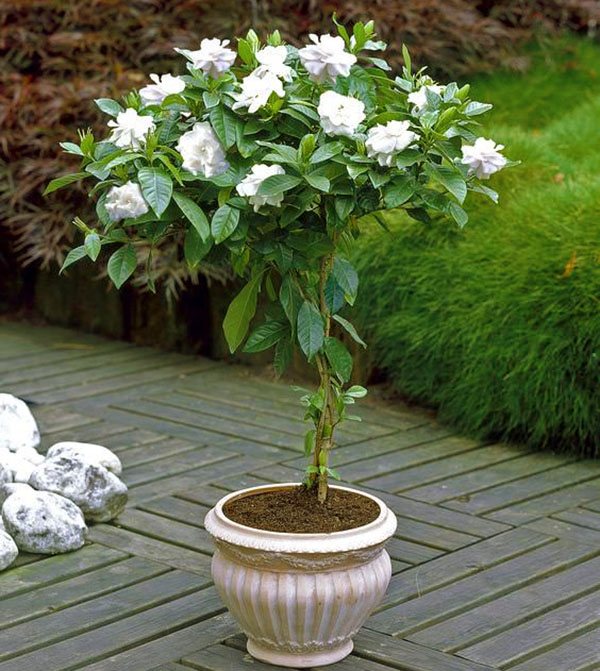

Rooting or jasmine gardenia is one of the most beautiful indoor plants.But if a gardenia settles on the windowsill, home care for it should be constant and very attentive.
In nature, this culture forms large shrubs or even trees. During flowering, they spread a magnificent fragrance for many meters around, and the most lush peonies and roses can envy gardenia flowers.
The first stories about the amazing gardenias that adorn the chambers of the Chinese emperors date back to the Song dynasty, which existed about a thousand years ago. Although gardenias could show themselves to the fullest in the palace, even then the gardeners tried to achieve the most lush flowering, preventing the growth of the crown. This is how gardenias became spectacular miniature bonsai. In Europe, where culture first appeared in the second half of the 18th century, it was also limited in growth by cutting and shaping the crown.
The choice of soil for planting
Gardenia does not take root in alkaline soils. For a plant, you need to pick up a soil that is good for oxygen and water. Specialized soil for planting azaleas can be purchased from qualified stores. But sometimes its quality does not correspond to the required one. The best option is a mixture of different types of soil:
- coniferous soil;
- sod land;
- high quality peat;
- coarse sand.
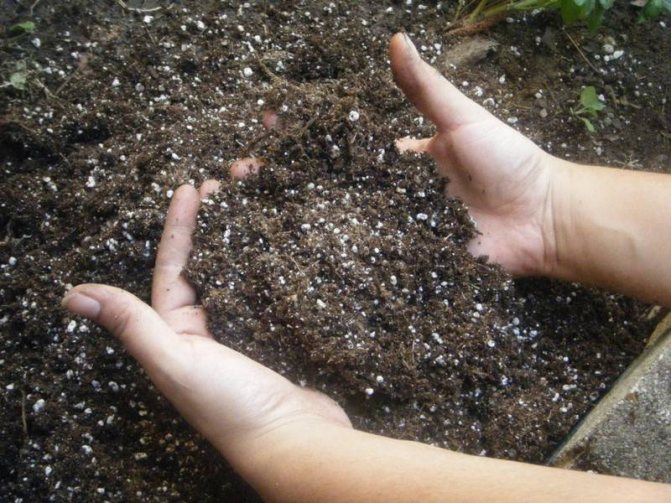

For planting, you need to mix all types of soil in the same ratio, disinfect with a special solution. The flower does not need to be removed from the pot in which it was purchased until the end of the flowering period. In stores, the soil is fertilized with chemicals that stimulate flowering, and then slowly kill the plant. It is imperative to drain the soil, allowing the roots to be saturated with oxygen.
The soil must be fertilized with potassium and phosphorus, avoiding large amounts of nitrogen. You need to feed the gardenia in accordance with the instructions on the fertilizer package, but the indicated portions are halved. Use the top dressing only for flowering plants.
Transferring to a new pot
To transplant a gardenia, you need to be consistent and accurate. It is important not to damage the root system of the plant. And first of all, you need to choose a suitable pot. If you have just brought a plant from the store, you should not pick up a huge pot for it - there is enough capacity, 2-3 cm larger in diameter than the store pot.
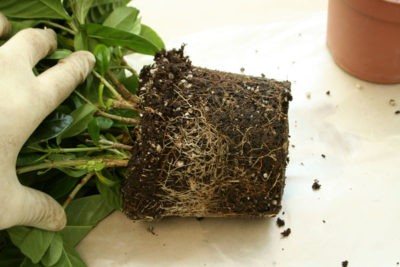

To correctly transplant, carefully remove the bush from the old pot together with an earthen lump. Try to remove the old soil from the roots (without fanaticism), and then place the plant in a solution with a biostimulant.- At the bottom of the new pot, it is necessary to place a steam-sterilized drainage (expanded clay or sphagnum), then pour a layer of clean river sand, then coal, only at the end - soil. The last layer should be more than any other, this is understandable.
- Remove the gardenia from the biostimulator, straighten the roots a little, place in a new pot. Sprinkle lightly on top with soil, crush the soil a little as you pour it.
- After the bush is in place, pour the soil on top with the bio-solution in which it was soaked. Then the pot must be placed in a warm, sunny place, but protected from direct rays.
Watch the video about gardenia transplant:
Photo of indoor flower
Take a look at the photo of what this exotic plant looks like:
Pruning
It is important to prune the plant to stimulate growth and long-term flowering. This procedure is carried out after the flowering stage, namely in the fall. First of all, diseased, damaged, underdeveloped processes are removed, this will add strength to the flower.
During the growing season, the lateral processes are pinched, thus, the bush looks more lush and neat.
ATTENTION! After plucking, the gardenia will bloom thicker, and so that healthy cuttings do not disappear, they can be used as planting material.
Flowering duration
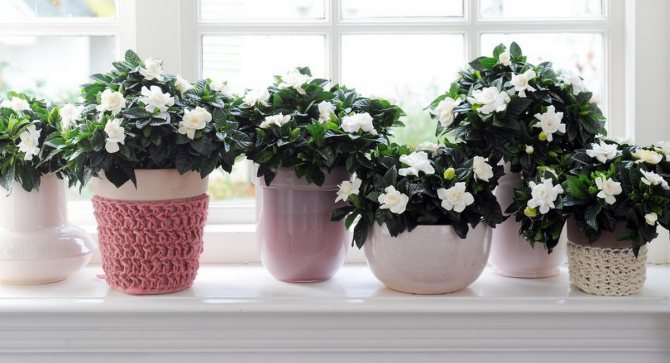

Since gardenia is primarily appreciated as a flowering plant, amateur flower growers are very interested in describing the timing of flowering. Almost all indoor species bloom from July to October. However, many experienced amateurs, having created the most favorable conditions for growing this plant, can boast of year-round flowering. Therefore, when deciding to purchase a gardenia as a green pet, be sure to seek helpful advice from the professionals.
Whether you want to decorate your flower collection with potted, abundantly flowering specimens or diversify the greenhouse assortment with tree-like tall bushes exuding a divine scent, then the regal snow-white gardenia will be the perfect purchase for you.
Popular ways and methods of breeding
There are several ways to reproduce an exquisite houseplant:
- cuttings;
- lateral layering;
- seeds.
Cut at the end of winters, at the beginning of spring, cuttings from the tops of the plant about 8-10 cm long are placed in a substrate at room temperature. Immediately before the rooting procedure, agents that stimulate root formation are used. Organize greenhouse conditions for the planted twigs by placing a glass jar on top of the market or covering it with a transparent plastic bag. Do not be discouraged if the rooting process does not give a positive result. Even experienced flower growers take a long time and find this process difficult. Usually the cuttings are placed in a special earthen mixture; rooting in water rarely gives a positive result. When the cuttings take root, they are pinched. When sowing the collected seeds in the sand under glass, be careful, gardenia fruits are poisonous, like the stems and roots.
Fertilizer
No need to overuse fertilizers, gardenia may die
Fertilizing gardenia soil is necessary during the growth period from the end of March to the end of August. In autumn and winter, feeding is stopped. It is necessary to take complex liquid fertilizers for flowering plants.
It is important not to overfeed the flower, therefore, the concentration of fertilizers should be done half as much as it should be according to the instructions. Fertilizers are applied only to wet soil twice a month.
It is important that no calcium is included in gardenia fertilizers.... This plant is very sensitive to the presence of this element in the soil and can stop growing and shed leaves.
Often during flowering gardenia lacks iron, which affects its appearance. Its leaves first lose their intense green color, and then begin to turn massively yellow. In this case, foliar feeding with ferrous sulfate is necessary.
The healing properties of the flower
Caring for a gardenia at home can seem daunting for beginner growers. But a well-groomed flower will delight not only with its wonderful aroma and bright large flowers. The plant has certain healing properties:
- compresses and decoctions are made on the basis of roots, flowers and fruits;
- prepared ointments are used for skin diseases and stomatitis;
- the use of a mixture of fruits helps to heal wounds, thin the blood, and eliminate inflammation.
You need to take care of a gardenia flower at home in the same way as for any capricious plant. Compliance with all the conditions of care will give a stunning result - it will delight you with exuberant flowering and active growth for a long time.
pion.
Gardenia belongs to the madder family. In the wild, this plant is found in South Africa, India and China. In total, there are approximately 250 species of the genus gardenia. Jasmine gardenia has become widespread as a houseplant. This shrub grows up to 1.8 m in nature, and at home its growth does not exceed 45-50 cm. This plant has glossy broad-lanceolate leaves. Flowers are single or collected in corymbose inflorescences of 4-6 pieces.White flowers up to 5-7 cm in diameter have a pleasant aroma. Home gardenia blooms in summer and autumn.
Gardenia should be sprayed frequently - several times a day. Also, caring for gardenia at home requires removing faded flowers. In the spring, when the growing period begins, the gardenia should be pruned to form a bush crown. Gardenia leaves can be treated with a plant-based leaf polish.
How to care for gardenia jasmine to achieve rich flowering? This requires a lot of effort and strict adherence to all the rules for caring for a flower. When purchasing or making your own soil mixture for gardenia, you should check its acidity. To do this, you need to pour a soil sample into an empty pot and water it, when the water drains, determine the pH level using litmus paper. In winter, you need to watch out for blowing from the window so that the earth in the pot does not become too cold.
Compliance with a certain temperature regime should be included in the care of gardenia at home, since this plant is quite thermophilic. It is kept in winter at temperatures between 16 ° C and 22 ° C. The best option is around 18 ° C. Sudden temperature fluctuations should be avoided.
This plant loves light, and home care for your gardenia should provide adequate lighting for the plant to grow and flower well. In summer, the plant should be protected from direct sunlight during hot daytime. Overly bright summer sun may turn gardenia leaves yellow or develop brown spots of sunburn. In winter, it is advisable to put the plant in the brightest place, and you can not be afraid of the direct rays of the sun at this time of the year.
Special watering also includes home care for your gardenia, including regular spraying. Watering should be abundant in spring and summer. In winter, it is more moderate. This plant does not tolerate overdrying of the earth, however, stagnation of water in the root system is also extremely undesirable. Water for irrigation at any time of the year should be lukewarm and always soft. It is good to use filtered or boiled rainwater for watering your gardenia. During the period of active growth (March - August), once every two weeks, the gardenia should be watered with liquid fertilizer for flowering indoor plants. The dose of fertilizer should be taken half the amount indicated in the instructions. Twice a year (spring and summer), iron supplements are added to lower the pH.
Gardenia care also includes a mandatory transplant, which is carried out in the spring, preferably every two years. Gardenia needs acidic soil with a pH of 4.5 to 5.5. The soil mixture for this plant consists of five equal parts: turf, coniferous, foliage, peat and sandy. A prerequisite is good drainage, best of all expanded clay, which is poured into the bottom of the pot. If you can't make your own potting mix, you can buy azalea potting soil at a flower shop.
Gardenia is propagated by cuttings in February - March. Cuttings are planted using phytohormones in soil heated to 25-27 ° C. When rooting cuttings in water, they are placed in a weak solution of rooting stimulants (root, epin or heteroauxin).
Possible diseases
When caring for a room gardenia at home, flower growers may encounter various pests or flower diseases.... Among the pests that destroy the leaves of the plant, there are:
- aphids;
- spider mite;
- whitefly;
- mealy worm;
- shield.
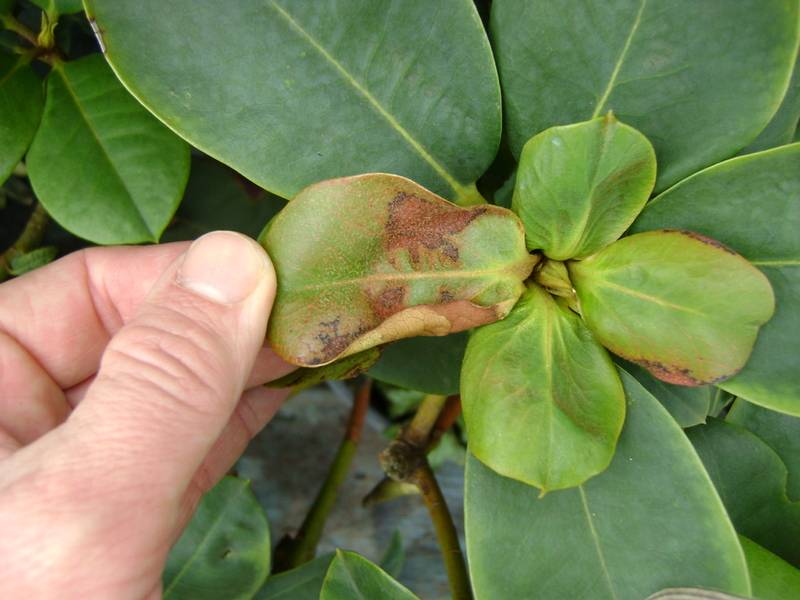

Insects make themselves felt by damaging the leaves. Dots, spots or small holes remain on them. Gardenia, affected by pests, very quickly stops blooming and stops growing, dries up.Therefore, it is urgently necessary to rid her of parasites. This can be done by washing the leaves of the plant with soapy water or using special products. You should not use folk recipes that a whimsical plant can reject. It is better to purchase quality insecticides and use them according to the instructions.
When infected with a nematode, it is necessary to immediately remove damaged areas of leaves, shoots and cuttings. This disease is not cured, spreads quickly and kills the flower in a few weeks.
Not only beauty, but also benefit
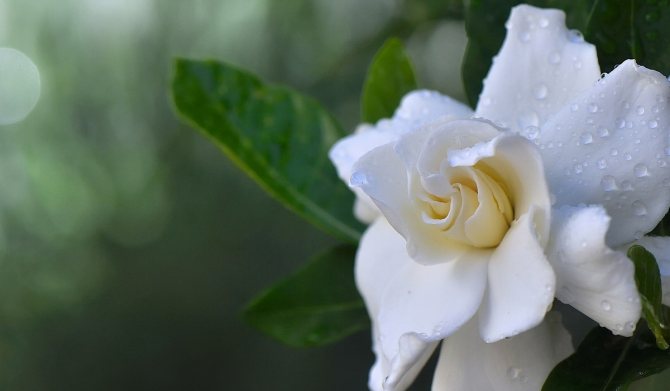

Gardenia species growing in natural conditions are actively used by local residents for medical and cosmetic purposes. To create traditional medicine, ripe fruits or roots are used. The plant helps in the treatment of gastrointestinal diseases, relieve headaches, reduce blood pressure, and treat kidney disease. The description of the medicinal spectrum of decoctions and pomace from gardenia parts is very broad. The fruits of this plant are used by modern medicine as a hemostatic or antipyretic agent. Gardenia flowers are added to herbal teas. Gardenia essential oil is widely used in aromatherapy and perfumery. Also, gardenia plant pigments are used to create natural dyes, usually yellow or orange. There is even a blue food coloring made from the herbal pomace of such a rare variety as blue gardenia.
Trim / Support / Garter
A gardenia bush must be shaped so that it attracts attention with its beauty. Pruning the plant will help with this.
Pruning is done after flowering ends or before growth begins at the end of February.... At this time, all shoots are shortened by 2/3 or half.
During the growth of the plant in spring, you need to analyze the shape of its crown and correct appearance errors.
At this time, long shoots can be pinched so that they give rise to several side branches.
Seed propagation
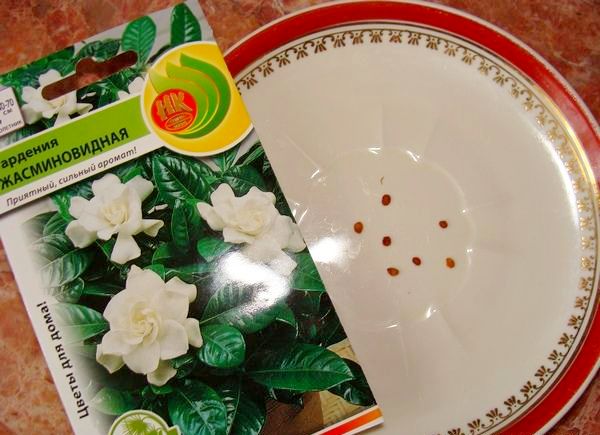

To grow an amazing gardenia at home, it is enough to buy seeds from the store. You can get them yourself, waiting for the end of the flowering period. Then a guaranteed high-quality material will be selected, which will be used in the future for reproduction of the shrub. This option is suitable for beginners and experienced florists. Fresh seeds can grow a healthy plant.
After the end of the flowering phase, several buds are left. They must mature. You should take care of the soil in which the flower will grow. The pot is chosen shallow, but wide. Small stones should be placed on the bottom to create a drainage layer.
Before planting, the seeds are soaked for a day in a solution to stimulate growth. Then they are placed in soil. The container with seeds is covered with foil and sent to a warm place. The air temperature should be at + 25 ° C. Periodically, the film is removed to moisten the seedlings. The first shoots will appear in a month, and the bush will begin to bloom in two years.
Diseases and pests of Gardenia
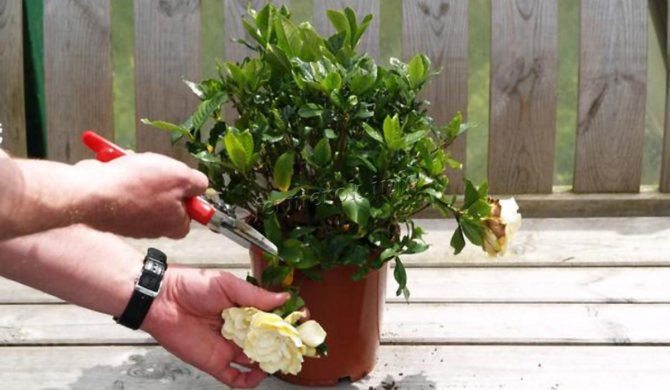

Gardenia pests
In the natural environment, the gardenia flower rarely gets sick, but in apartments, due to the dry climate, lack of certain substances, poor conditions, diseases often affect it, just like pests.
- If the leaves become discolored and brown worms appear on them, then these are worms. They must first be removed from the plant one at a time with a cotton swab dipped in denatured alcohol, and then spray the culture with a systemic insecticide like Fitoverm, Intavir.
- Ticks are easy to spot if the leaves and the ground underneath turn yellow. Treatment with a systemic insecticide (Fitoverm, Intavir) or malathion and an increase in air humidity can help in this situation.
- Mealybug causes white, wavy specks on the leaves. They get rid of them, as well as from simple worms - with a swab dipped in denatured alcohol, and then spraying with a systemic insecticide.
- Chlorosis is an excess of calcium in the soil. It provokes yellowing of the leaves, but the stems remain green. To reduce the amount of calcium, you need to water the gardenia flower with fertilizer with iron, and then also with decalcified water.
- When a particular disease appears, it is worth spraying the plant with a systemic fungicide.
Watering
The bush should be watered regularly. Potted soil should never dry out completely. In the summer, watering should be abundant, but this does not mean that the plant needs to be poured.
Any stagnation of water in the ground leads to root rot, in which it is very difficult to save the plant. In winter, watering is somewhat reduced. Water so that the soil in the pot always remains only slightly damp.
Water for irrigation should be soft and settled. It should have a temperature 2-3 ° C higher than the air temperature.
This tropical plant loves high air humidity. This is especially important during the period of budding and flowering. It is necessary to humidify the air by spraying near the plantso that its buds do not fall off.
To maintain high humidity, you can also place the bush pot in a deep tray with coarse wet sand or expanded clay.
Description of the species and varieties
Of the more than 350 types of gardenia in indoor floriculture, only one is grown everywhere - the jasmine gardenia. It is a perennial ornamental flowering shrub with dark green shiny leaves.
In the wild, it often exceeds 2 m in height, and in an apartment it rarely reaches 1 m. In the spring-summer period, its branches are covered with white fragrant flowers.
This species gave rise to several varieties, differing in the shape and size of the flowers, as well as the color of the leaves. The variegated form "Variegata" is very beautiful with white-green leaf blades. There are large-flowered and terry forms, as well as varieties famous for their long flowering period.
In addition to this species, among lovers of flowering plants, you can find other types of gardenia. Usually these are compact plants:
- Gardenia radicans is a species not exceeding 70 cm in height;
- Gardenia Vietnamese, characterized by irregular white flowers and large dark leaves;
- Gardenia citriodora is a rare compact species with very small white flowers.
In the gallery you will see photos of gardenia, including jasmine, in the process of home care and in natural conditions:
Diseases
Consider how to care for your gardenia at home when the flower is sick.
Of the fungal diseases, rotting of buds and flowers, and root rot are most common in gardenias. To avoid this and maintain the appearance of the plant, you need to properly spray the plant and water it regularly and little by little.
On the bush, especially if it is taken out in the open air for the summer, almost all known pests of indoor plants can settle.
Gardenia is especially often affected by: thrips, aphids, scale insects, red spider mites.
To destroy harmful insects, you need to use only purchased insecticidal preparations (decis, actellik). This will greatly simplify the treatment of gardenia diseases.
If harmful insects have multiplied strongly, a week after using the drug, you need to repeat the treatment.
Lighting and temperature mode
The temperature and brightness of the light play an important role in how to care for the gardenia flower. there is enough dim sunlight, so the pot can be placed on windowsills in any direction, except for the north. With a lack of lighting, you need to use special phytolamps. South or west facing windows can be hazardous to the plant. The bright rays can burn the leaves and delicate gardenia petals. In this case, you need to create a light shadow using sheets of white paper or light fabric.
The temperature regime for the flower is kept within strict limits. The plant develops correctly and blooms at a temperature of 17-23 degrees.The slightest change in either direction can seriously harm a gardenia. In winter, it is enough to put plastic or glass between the pot and the window - this will help keep warm.
Protecting yourself from high summer temperatures is more difficult. To do this, fill a few small bottles with water and place them in the freezer. Ready-made mini-air conditioners are placed near the pot, cooling the air. As soon as the ice in the bottles melts, they need to be replaced with new ones. You need to be careful, because hypothermia can also kill a flower.
Pest and disease control, treatment methods
Enjoying the sophistication, beauty of an amazing flower, regularly inspect the flower for the presence of plant pests. Danger threatens from defeat scabbard, spider mite, mealybugoften attack thrips and aphids... For prevention, insecticides are used in pest control. Suitable drugs such as:
- decis;
- intavir;
- confidor;
- fitoverm;
- politox.
If the lesion is small, one treatment is sufficient. If pests attack the plant, several sprays will be required at intervals of seven to ten days. Usually, three treatments are enough, but to avoid relapses, a preventive treatment is done every six months. Before using a toxic drug, take precautions, it will not be superfluous to read the instructions for use in order to calculate the correct dosage. In some cases, pests do not breed on gardenias, but on neighboring flower pots, in which case all the inhabitants of the windowsill should be treated at the same time.
Moisture and watering of the plant
Taking proper care of your gardenia at home requires proper watering and moderate humidity. The air in the room should always be humid - this is a very important factor for the proper development of the flower. If possible, you can spray the gardenia crown several times a day with cool water.
You can also create the required level of humidity in other ways:
- the pot with a stand must be placed on a pallet with peat, hydrogel and sphagnum. Water is periodically poured into the pallet;
- glasses and saucers with water are placed on the windowsill with the plant;
- a constantly switched on humidifier will help;
- in winter the gardenia is placed on the window under which the batteries are located. To humidify the air, wet towels are hung on the radiators and changed as they dry.
It is best to use all methods of creating comfortable moisture for growth at once. The plant does not tolerate dry air, so it is also optimal to create a small greenhouse for it on the windowsill. This will help maintain a pleasant microclimate for the flower at any time of the year.
I don't like gardenias and dry mail. The plant can abruptly end the flowering period if there is a lack of watering. Soil moisture levels must be strictly controlled. The soil should be moist, which can be checked with a wooden stick. It is stuck into the pot to the full depth and the moisture content of the earth is checked after fifteen minutes. You can buy special beacons in stores that control the amount of moisture. They are placed in a pot, and when it dries, the beacon will begin to change colors.
Gardenia is also demanding on water quality... It must be boiled, filtered, cooled and defended. Every one to two months, lemon juice or a few grains of acid are added to the water - it prefers acidified moisture.
If you do not have time to prepare irrigation water, you can purchase preparations for aquariums. They purify and heat water in a few hours, making it suitable for living organisms.
Transplanting, watering and feeding a flower
Transfer
A transplant of an overgrown flower should be done in February or early March, having prepared the soil in advance. As a rule, the plant should be transplanted no earlier than two years of growth and only after it has faded.A transplant is stressful for a flower, it can shed its buds.
We install good drainage from small pebbles into the pot prepared for transplantation; some growers use large pieces of foam. The soil prepared for planting should not contain lime impurities. The ideal option is to purchase a ready-made potting mix, which is sold in flower shops or garden partnerships. By choosing the right composition, you can buy azalea soil that is slightly similar to gardenia in care and a corresponding oxidized soil mixture.
Mixing the soil for the plant on our own, we take the following proportions: the earth from under the needles, leaf and peat soil is combined with an equal share of sifted, clean sand.
Top dressing
When the plant is in the phase of active growth, from about March - April to August, they are fertilized with liquid fertilizers for indoor plantings, intensively and abundantly flowering. Fertilize after a couple of weeks, observing a reduced dosage than indicated in the recommended instructions.
Planting and leaving
The peculiarities of planting is the need to cut the shoots by one third of the entire length. Propagation by stem cuttings cut in the spring from the mother plant is the best way to get a new gardenia bush.
The plant loves moist air and needs constant moisture. Spraying every day and placing the gardenia in a tray filled with pebbles of water will provide a pleasant microclimate that resembles a natural habitat. Great for comfortable growth and flowering of gardenia, windows directed to the west, east, south windows are suitable for winter. The most important thing in caring for a capricious beauty is the correct temperature regime. In summer, the temperature should be at least 21-22 degrees Celsius, in winter about 18-19. The presence of a falling shadow from trees growing in the yard is highly undesirable.
Features of the
This capricious plant does not tolerate moving to another apartment very badly. Therefore, even a quick transport of gardenia after purchase often turns into the death of the plant.
The flower loves a stable air temperature... In winter and summer, it should not differ by more than 3-4 ° C. And sharp jumps in temperature during the day are generally unacceptable.
With a sudden change in air temperature, the gardenia can shed all the buds and flowers.
During budding and flowering, the gardenia cannot be transferred to another room and even the pot must not be turned.... Otherwise, all the buds will fall off and the plant will not bloom.
Correct gardenia transplant
Young plants require an annual transplant, and subsequently no more than once every 2-4 years. When transplanting, part of the root system is cut off.
If the flower has been moved to another place, then it should be transplanted only after one to two months. It is believed that this time is sufficient for the plant to "cope with stress."
Transplanting a gardenia takes place by removing the plant from the pot, freeing the roots from the substrate and then placing it in a larger pot with fresh soil.
A slightly acidified soil rich in nutrients is used. You can use soil designed for planting azaleas. If you prepare the soil for transplanting yourself, then mix sand in equal proportions with peat, turf and coniferous soil. Sand can be replaced with vermiculite or perlite.
Sometimes sphagnum is added to the pot, which slightly acidifies the soil. To prevent alkalization of the soil, when watering, you can add a couple of drops of citric acid to the water.
In order to give the gardenia an aesthetically pleasing appearance, it is periodically pruned. It is carried out at the end of flowering. During the first year after purchasing a flower, it should not be subjected to this procedure.
Propagation by cuttings
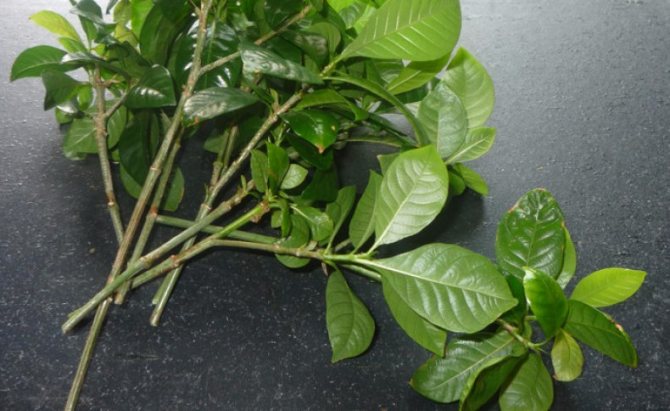

In early spring, flower growers are planting gardenia.The stalk is obtained from the top of the plant, which is cut 10 cm. A sharp knife should be chosen. With the help of such a tool, a smooth cut will be obtained. The leaves are carefully removed, at the very top you just need to leave two pieces. Before planting, the cutting is immersed in a weak solution of potassium permanganate. You can use a growth stimulant for these purposes, in which the shoot is left for 5 hours. The cuttings are planted in the soil and covered with a film or jar. In a month, new shoots will appear. If the cutting is well rooted and begins to grow actively, it is transplanted into containers for permanent cultivation.
A very whimsical plant - to take or not to take ?!
As beautiful as the indoor gardenia is, it is just as capricious. Reviews are mixed. Many growers did not have the patience to grow a full-fledged beautiful flower.
- Home gardenia is very fond of light, warmth, high humidity.
- Drafts are destructive for her.
- Separately, it should be said about watering. Tap water is too hard for her. She needs watering with soft, settled water, preferably rainwater.
- The plant cannot be frequently rearranged, the temperature regime must not be changed.
- Flowers that have faded must be cut off immediately.
- Its leaves can be coated with a polish based on natural ingredients.
Only a few growers manage to please the capricious gardenia. If this succeeds, a real exquisite decoration will appear in the house, which will easily fit into any interior.
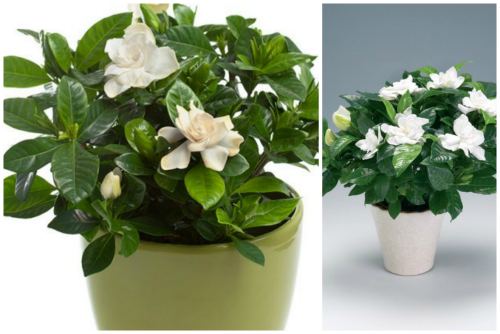

For a beginner, buying this beauty will most likely be a temporary purchase. At first, she will delight everyone in the family with lush flowering, new leaves may appear. However, after a month, the plant will begin to shed the initially unblown buds, and then foliage will follow. This is an alarming signal that does not bode well. Gardenia cannot be reanimated.
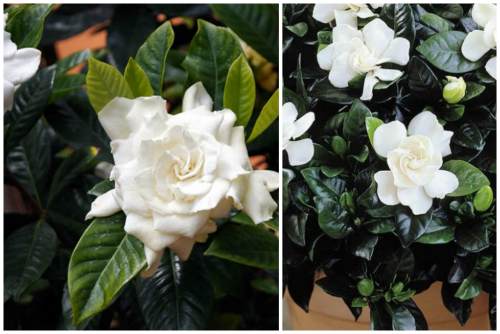

This disastrous result signals more than just your mistakes. We mostly buy gardenias from Holland. In Europe, all flowering plants are bought precisely because of the beautiful, exuberant flowering. Therefore, the manufacturer makes every effort to stimulate the appearance of buds as much as possible. For this, a complex of fertilizers and artificial lighting are used. The result is achieved - on the shelves of flower shops there are many lush green bushes, all dotted with buds and flowers. But a one-off effect. The flowers are so depleted that they die after flowering. In fact, it is an alternative to cut flower bouquets. They will stand longer, but will not settle in the house for many years, such as monstera, ficus.
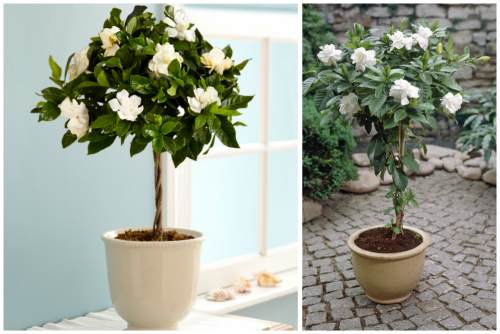

general information
Gardenia is a plant of the Madder family. This plant itself is a small shrub. - only undersized varieties are suitable for breeding at home. The historical homeland of the plant is the southern countries: India, China, Japan, it is also found in the wild on the African continent.
Most often, jasmine gardenia and its many varieties are bred at home. Less often - other types: radikans, Kula, citriodora, Hawaiian, etc. Next, let's dwell on the most popular varieties of this plant in more detail.
Spraying
The flower loves frequent spraying during intensive growth and flowering. However, when buds and flowers appear, water should not fall on them.
During the flowering period, water can be sprayed only near the plant so that the water that gets on the buds does not lead to their decay.
It is useful to spray the gardenia through a fine water sprayforming very fine droplets.
The procedure is carried out early in the morning so that the wet plant does not fall under the rays of the sun. This can lead to burns.
It is also not recommended to spray the bush late in the evening, so that it does not remain wet overnight. It can also provoke the appearance of various fungal diseases on the plant.
Indoor varieties
The genus Gardenia has 134 species, but for decorating living quarters they are mainly bred jasmine gardenia.
Gardenia jasminoides or Cape jasmine (Gardenia jasminoides)
A tree-like shrub with smooth shoots grows up to 1.8 m in height. Gardenia is easily recognizable by its large snow-white flowers (up to 7 cm in diameter). Flowers are located on ligneous shoots in inflorescences or single double cups. The jasmine gardenia, which is cultivated for ornamental purposes, blooms longer than a wild plant.
A characteristic difficulty in growing a tropical flower is its whimsicality to microclimate conditions. Gardenia does not tolerate fluctuations in temperature, lighting and air humidity, it reacts painfully to them by fading, dropping flowers and blackening of leaves.
In winter, when daylight hours are significantly reduced, additional lighting is provided to the shrubs. In the summertime, the gardenia is darkened. The natural habitat of the species is the forests of China and Japan.
Gardenia profusely (Gardenia Florida)
The variety is attractive with fragrant flowers that resemble camellia in appearance. In terms of beauty and richness of aroma, a white gardenia bush can compete with a rose bush - it is often used to decorate rooms.
Gardenia Radicans
A dwarf variety of gardenia, very popular among flower growers. A small bush with a rounded crown reaches a maximum of 60 cm in height. It can be used to grow bonsai. Fragrant large flowers delight the eye for a long time, subject to proper watering and feeding.
types, home care, how to care for a jasmine, why they turn black, leaves fall
Gardenia (Gardenia jasminoides) has long been prized for its long-lasting aroma. The essence is used in perfumery and cosmetic production. Despite the fact that the flower is very thermophilic, thanks to greenhouse cultivation, it is available all year round.
Material content
Botanical description of gardenia
An evergreen thorny shrub that belongs to the Madder family. In natural conditions, it can reach 2 meters. It has branching stems with scaly bark, wide and shiny leaves 8 cm long. The flowers are white and large, up to 8 cm in diameter. There are also decorative varieties with double flowers. Gardenia fruits are yellow-orange in color and are edible.
The homeland of the shrub is China, the subtropics of Africa and Japan. For a favorable development, it is recommended to use acidic soil. The plant is popular with gardeners not only because of its beautiful appearance, but also because of its pleasant delicate aroma reminiscent of jasmine.
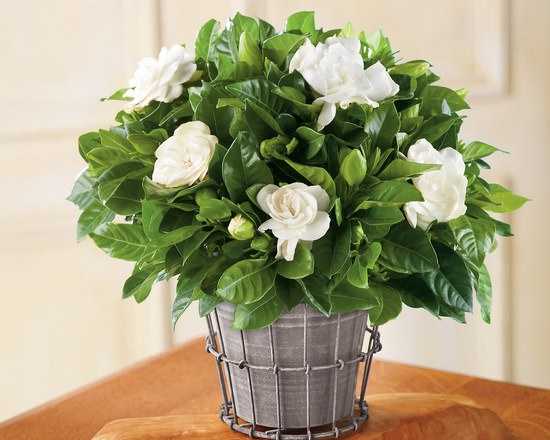

Gardenia is an evergreen thorny shrub that is part of the Madder family
Characteristics of gardenia species
Today botany knows about 250 species of gardenia.capable of growing in the wild to the size of a small tree. For growing in home and greenhouse conditions, flower growers most often prefer jasmine gardenia, which usually does not exceed 50 cm, but can grow up to 1 - 2 m.
Gardenia jasmine (Augusta) and its varieties
Gardenia jasminoides or Gardenia Augusta (Gardenia jasminoides, Gardenia augusta) may have another name - Caspian jasmine. Dense dark green shiny foliage is combined with delicate white flowers.
We also recommend reading:
During the flowering period, the shrub is abundantly covered with buds, making the plant unusually beautiful. The smell spreading to the whole room is able to create a spring atmosphere. The most commonly cultivated species with white inflorescences, but there are also pink, cream and pale yellow flowers. Gardenia blooms at any time of the year. Even the winter months are not an exception.
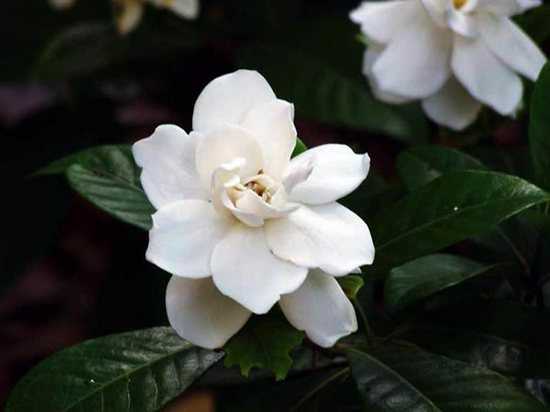

Gardenia jasmine (Augusta)
The following garden forms are common:
- Radicans - double white flowers, smooth lanceolate leaves;
- Kleim's Hardy - small white waxy flowers that adorn the shrub in spring and summer;
- Four seasons - blooms in comfortable conditions all year round;
- Fortuniana - large camellia-shaped terry flowers;
- Variety Veitchii - has delicate double flowers and shiny dark green foliage;
- First love - Terry light cream flowers can appear 2 times a year;
- Variegata - bush leaves with light yellow speck, white and double flowers;
- White Gem - small dark colored oval leaves and 5-petal stellate flowers;
- Mystery - blooms in large flowers for quite a long time.
Gallery: gardenia (25 photos)
How to propagate a gardenia (video)
Other types of gardenia
Unlike indoor flower cultivation, in natural nature, many magnificent varieties grow:
- CITRIODORA. The plant is an excellent decoration for a greenhouse. The name itself speaks of a subtle citrus aroma of white flowers.
- Gardenia is globular. The peculiarity of the species lies in the decorativeness of the form. The flowers also differ from other gardenias. They are bell-shaped and exude a vanilla aroma.
- Keeled. On a neat crown, magnificent buds of cream and light orange color bloom.
- Forest or Hawaiian. Cultivated in parks or garden plots. The bush has 6 petal flowers.
Many varieties of gardenia have been obtained through selection. As a result, experts cannot accurately determine which plant forms were created artificially and which of them are natural.
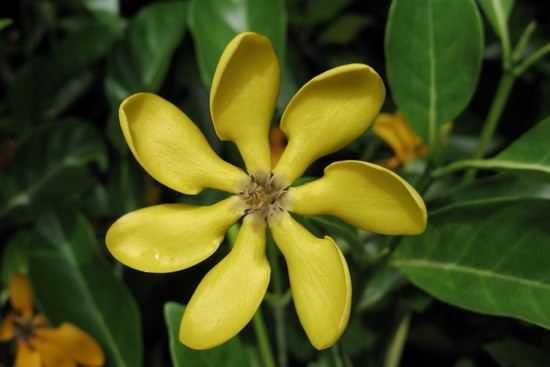

Gardenia Keel
Home gardenia tips for beginners
Since the plant requires special care, only the jasmine gardenia has taken root in indoor cultivation. It is rather difficult to create conditions close to natural ones. For the favorable development of the plant, a lot of effort is required.
Lighting, temperature and humidity
The indoor climate should be as close to the tropics as possible. The plant needs full lighting. It is desirable that the sun's rays be present in the room all day. However, in the hot summer period, the plant must be protected from ultraviolet radiation. The best placement option may be places near window openings facing the west and east sides. Since the flower is sensitive to light changes, during the period of laying and developing buds, it is forbidden to rearrange and unfold the pot with the plant.


The best placement option for gardenias may be places near window openings facing the west and east sides.
Avoid sudden temperature changes. In the summer months it is recommended to maintain between + 20 ° and + 25 °. In winter + 18 °, at least + 16 ° is allowed. The plant is badly reflected by hypothermia of the soil and drafts. Unfavorable conditions lead to the release of buds.
To create the necessary humidity, dishes with a flower should be placed in a container with wet moss, expanded clay or pebbles. Several times a day, the plant should be sprayed with water, but in such a way as not to affect the flowers.
Soil and flower pot
For a gardenia to grow well, it is necessary to properly care for the flower. The tree prefers acidic or slightly acidic loose soil. Ready-made soil for azaleas is suitable. To prepare the substrate yourself, you need to mix coconut fiber, peat, sand and vermiculite. To maintain the required acidity, you can use acidified water (5 - 6 drops of lemon juice per 1 liter of water).
At the bottom of the pot, there must be a drainage layer of at least 3 cm, and the pot itself must be suitable for the size of the flower.
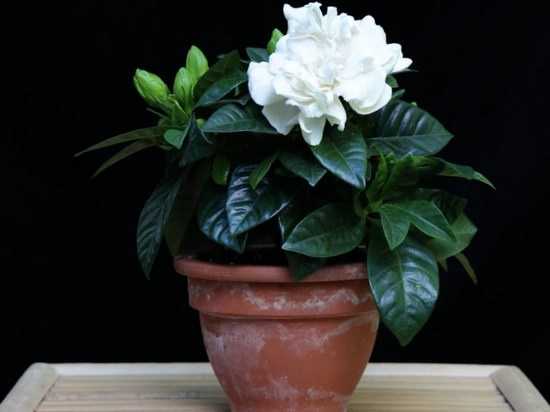

Gardenia prefers acidic or slightly acidic loose soil
Watering
In the process of caring for a flower, it is important to monitor the moisture content of the soil, which in no case should dry out, otherwise the plant will die. You should not also water abundantly, to prevent waterlogging, especially in the cold season. Experts recommend watering every day in the evening. Water can be boiled, but, most importantly, soft and not chlorinated.
Flower feeding
Young seedlings need mineral and organic fertilizers. The frequency of such feeding is twice a month. Adult trees must be fed with fertilizers every 7 days. It is important to ensure that the products do not contain calcium.
Terms and rules for gardenia transplant
Due to the fact that the root system of gardenia grows rapidly, it needs a constant change of the pot. To transplant a plant, you should wait until the end of its flowering. The optimal period for transplanting an adult shrub is every 2 years, young specimens must be replanted every spring. To avoid overheating the roots and retain moisture, cover the soil from above with pine bark or coniferous needles.
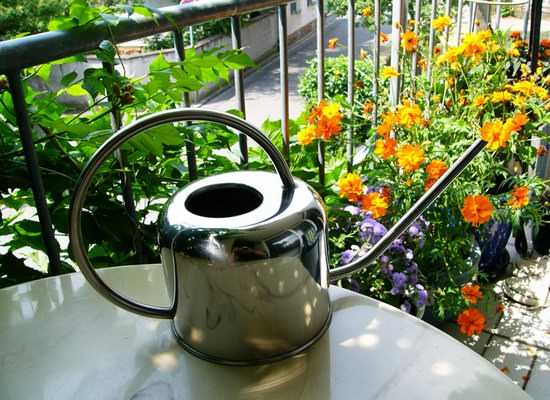

Experts recommend watering gardenias daily in the evening.
Pruning and shaping the crown
Throughout its life, the gardenia needs to form a crown. Pruning can correct the irregular shape of the plant or rejuvenate it. For the procedure, you will need a special tool (knife, pruner) and charcoal. Creating a compact crown requires following some rules:
- In the case of pruning a young plant, all lateral shoots should be removed in February, leaving the leaves on the trunk. After the gardenia has grown in height, the top bud should be pinned off. This procedure will not allow her to grow. The same pruning of shoots is carried out in the fall. Damaged twigs are removed completely, and with the help of healthy elements, the shrub can be propagated.
- The cut site must be treated with charcoal or activated carbon, otherwise the branches will dry out or infection with pathogenic bacteria will occur. In addition to coal, you can use sphagnum or a talker made from clay.
- Using a special circumcision technique. Semi-lignified twigs are removed first. In the case of using a branch as further propagation, there should be a bud at its end, and the upper young leaves should be cut off. In order to avoid premature drying of the trunk, large shoots are cut in half.
The day before pruning, the plant must be watered abundantly.
How to transplant a gardenia (video)
Problems with growing gardenia
A beautiful plant needs special care, but not as complicated as it might seem at first glance. Knowing some of the features of gardenia, even an inexperienced florist can grow a flower.
Why gardenia leaves turn yellow and fall
The most common ailments are leaf problems. They lose color and fall off. The main symptom is unfavorable climatic conditions.
- violation of irrigation and water quality;
- unsuitable substrate;
- chlorosis associated with a lack of iron in the soil;
- insufficient lighting;
- depletion of the soil.
The flower does not tolerate both a lack of nutrients in the composition of the soil and an overabundance. When watering, the water should not linger in the pot.
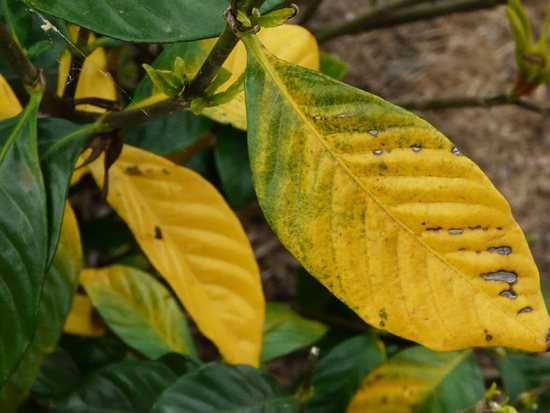

Gardenia does not tolerate both a lack of nutrients in the soil composition and an overabundance
Causes of blackening of plant foliage
There are several reasons for leaf blackening. Among the most common are:
- overdrying or waterlogging of the soil;
- drafts;
- the presence of pests such as spider mites;
- thermal burns as a result of exposure to ultraviolet rays on the leaves after spraying.
To prevent leaf damage, it is necessary to use iron-based fertilizing and water with water with the addition of lemon juice.
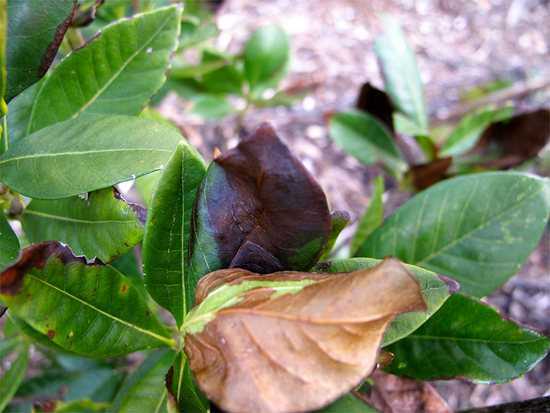

Overdrying or waterlogging of the soil is one of the reasons for the blackening of gardenia foliage
What to do if gardenia does not bloom
Possible reasons include:
- inconsistency in ambient temperature;
- lack of sunlight;
- lack of nutrients;
- too dry air;
- alkaline soil.
After correcting the shortcomings, buds will appear on the gardenia.
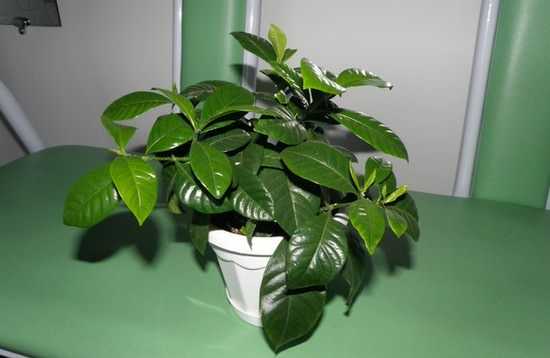

Gardenia's lack of flowering may be due to lack of sunlight.
How to avoid falling buds of gardenia jasmine
It is very annoying for flower growers when, instead of the buds opening, they begin to fall off. Why is such an unpleasant phenomenon happening?
- low air humidity;
- draft;
- sudden changes in temperature;
- changing the place of the flower pot;
- untimely transplant.
It is not recommended to rotate the flower pot in relation to the light source. If the plant was purchased already with buds, but it is not recommended to replant it until it has faded.
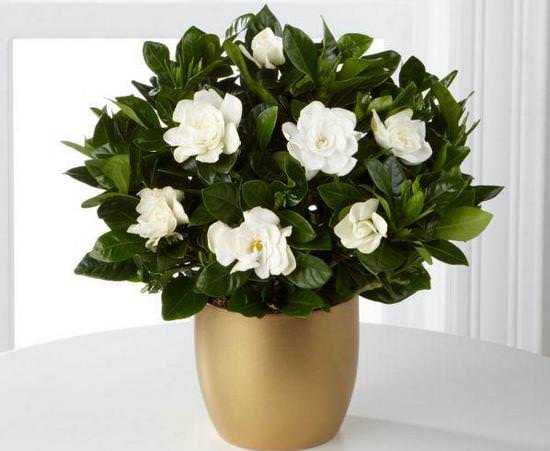

It is not recommended to rotate the flowerpot during flowering relative to the light source
How to reanimate an indoor gardenia
It happens that as a result of improper care, the plant gets sick.... Experts recommend several steps, the implementation of which can revive the flower.
- Removal of dry and blackened branches and leaves. All fallen leaves should be removed from the tree as they may become infected.
- Remove the plant from the pot and remove any rotten or damaged roots, which ideally should be light.
- Plant the flower in a new, suitable pot. Before planting, the roots should be powdered with root.
- After transplanting, you do not need to water the plant if the soil is very wet or the roots have been damaged. Otherwise, water a little.
- Spray the bush with Epin, but not with Zircon.
- It is important to maintain high humidity for two weeks after transplanting.
- The flower pot must be placed in the sunniest place, but in such a way that direct rays do not fall on the plant.
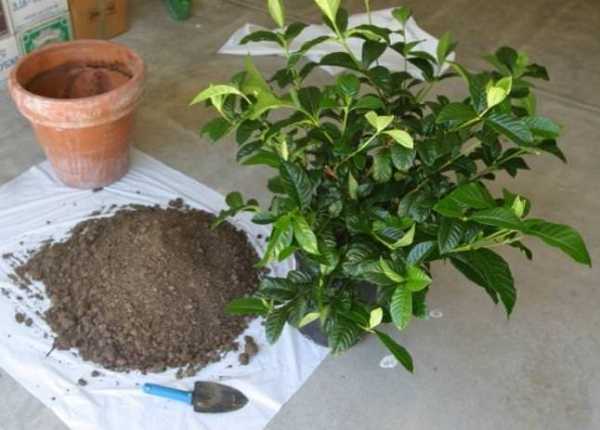

If the gardenia is sick, it is recommended to plant the flower in a new pot of suitable size.
It is not recommended to divide the bushes unnecessarily, since more than 4 cuttings can grow in one container. This procedure injures the flower, which entails negative consequences.
Diseases of gardenia and methods of their treatment
As a result of the lack of attention to the needs of the flower, it begins to fade. Inappropriate soil, temperature fluctuations, sunburn threaten that the gardenia stops blooming, and its foliage turns yellow. Possible causes of plant diseases and ways to eliminate them:
- A change in the color of the leaves and a decrease in their size indicates that the soil should be acidified with citric acid or watered with a weak solution of iron sulfate.
- To avoid stains during watering and spraying, it is important to ensure that no water gets on the flowers.
- Among the pests that infect indoor plants, the scale insect and spider mite most often appear on gardenia. To prevent this misfortune, it is necessary to keep the plant clean and provide suitable humidity. It is recommended to remove the affected parts and treat the flower with a systemic insecticide. The procedure must be repeated until the pests are completely eliminated. The scabbard can be easily removed with a cotton swab dipped in soapy water, and then rinse the plant with clean water.
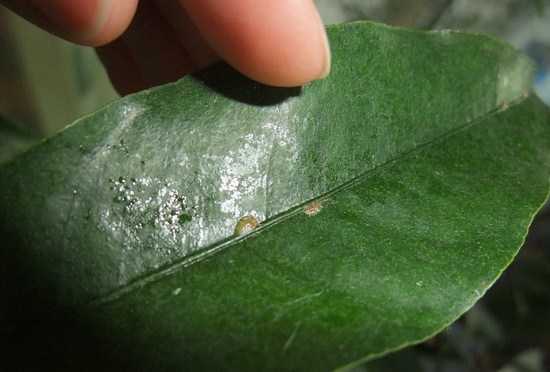

Among the pests that infect indoor plants, the scabbard most often appears on the gardenia.
Gardenia breeding methods
Gardenia reproduces in two ways:
- using seeds;
- by cuttings.
In home cultivation the seeds almost never used, since this method of flower cultivation is very difficult and rarely satisfies with a successful result.
The second way implies harvesting cuttings young shoots not exceeding 10 centimeters in length. To form roots, they must be placed in water with the addition of a growth stimulant or in a soil mixture consisting of peat and sphagnum. Reproduction is recommended from December to March.
In order to avoid damage to the delicate roots when transplanting into a new pot, the seedling should be transferred using the transshipment method. To form the crown, it is necessary to pinch the tops of the shoots.
Secrets of growing gardenia (video)
By following the recommendations of experts when growing gardenia, you can regularly admire its delightful and fragrant flowering. Due to its extraordinary beauty, the ornamental plant can be a decoration for any home.
Attention, only TODAY!
Rate Loading ...
How to reanimate an indoor gardenia
It happens that as a result of improper care, the plant gets sick.... Experts recommend several steps, the implementation of which can revive the flower.
- Removal of dry and blackened branches and leaves. All fallen leaves should be removed from the tree as they may become infected.
- Remove the plant from the pot and remove any rotten or damaged roots, which ideally should be light.
- Plant the flower in a new, suitable pot. Before planting, the roots should be powdered with root.
- After transplanting, you do not need to water the plant if the soil is very wet or the roots have been damaged. Otherwise, water a little.
- Spray the bush with Epin, but not with Zircon.
- It is important to maintain high humidity for two weeks after transplanting.
- The flower pot must be placed in the sunniest place, but in such a way that direct rays do not fall on the plant.
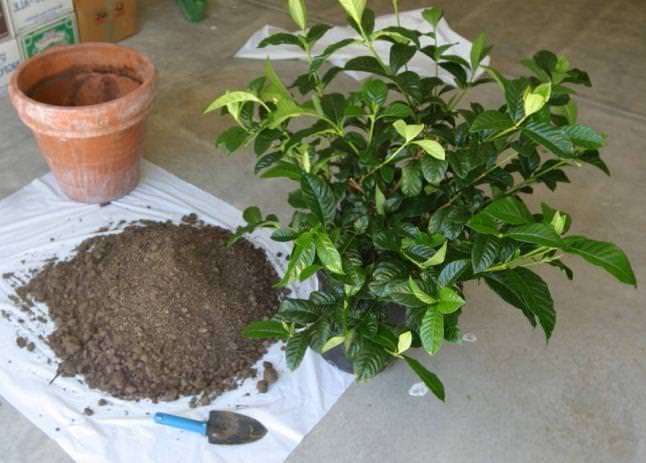

If the gardenia is sick, it is recommended to plant the flower in a new pot of suitable size.
It is not recommended to divide the bushes unnecessarily, since more than 4 cuttings can grow in one container. This procedure injures the flower, which entails negative consequences.
Secrets of choosing a plant in a flower shop
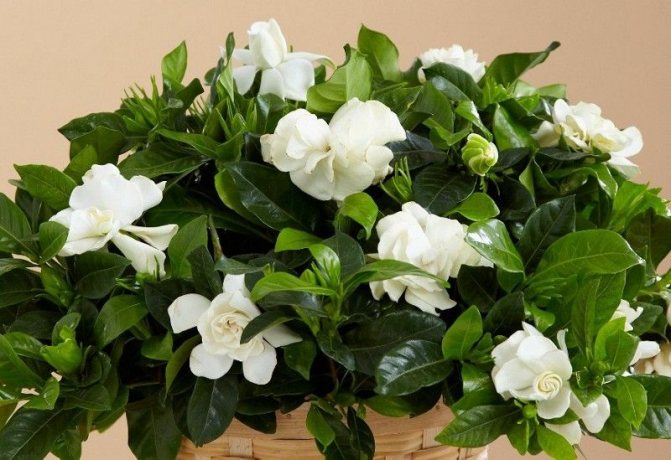

Before purchasing the desired exquisite and fragrant flower, a thorough inspection should be performed before purchasing. It is better to choose a bush with a well-formed, branched shape in different directions. If the plant initially seems sick, it has pale, yellowed or sluggish leaves, do not rush to buy. A drooping plant with crumbling flowers will not bring joy, satisfaction from enjoying its aroma and appearance.
A healthy plant looks gorgeous and costs a lot, but it is not worth saving money by buying a sick plant even with a significant discount. Remember, the miser pays twice. A gorgeous flower, with proper care, will delight you with an abundance of beautiful flowers. Filling the room with a delicious, pleasant scent reminiscent of jasmine.
Plant adaptation after purchase
Like other whimsical plants, gardenia, after changing its "place of residence", needs quarantine and a period of adaptation. Quarantine is respected in order not to infect other indoor flowers with pests, if any. The adaptation period in the new location is 15 to 20 days. Only after this period the flower can be transplanted into a permanent pot.
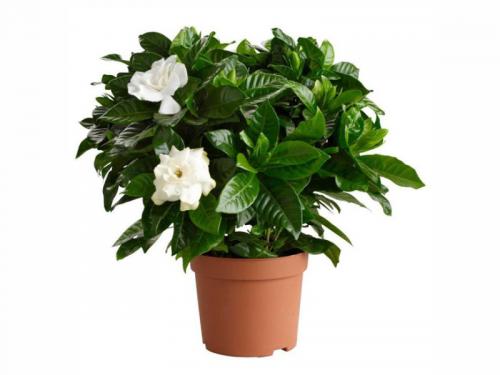

In the store, the plant is in soil containing few useful substances (it is intended only for transportation), so it is necessary to transplant the flower, even if you have to sacrifice the buds.
What to do when the flowering is over?
After the buds have fallen off, the shoots are cut to half, the damaged and dried parts are removed, and their tops are pinched to stimulate the growth of young lateral shoots.
To form a crown of the desired height, the plant's growth point is pinched.
Top dressing
1-2 times a week, mineral or organic fertilizers are applied to the soil. For adult plants, a calcium-free fertilizer is selected.If the leaves turn yellow, a solution of ferrous sulfate is added to the soil.
When buds are formed, you should rid the soil of excess acidity, for this, use fertilizers that contain iron.
A favorable time to start feeding a pot with a young plant is determined by the degree of development of the root system: if the roots have filled the entire pot and quickly absorb moisture, then it's time to apply fertilizers, alternating organic with mineral fertilizers.
Gardenia - species
Jasmine (Gardenia jasminoides)
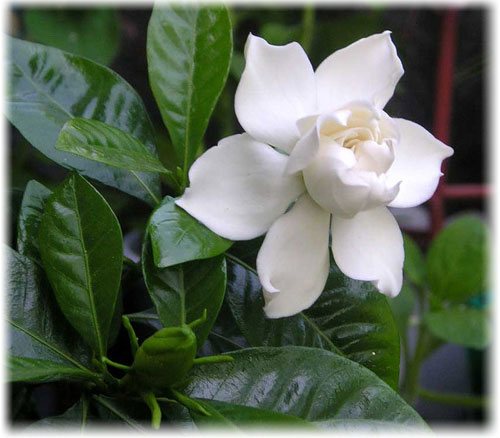

Prefers tropical forests of Japan and China, with a moderate height. In the natural environment, the height of the shrub is 2 m, in home greenhouses and gardens it does not exceed half a meter. Leaves are lanceolate, monochromatic, 8 cm long. A vein is clearly visible along, veins are evenly less noticeable to the side. Glossy leaves of green or dark green color. Often single flowers in leaf axils. The main color is white, turning into different shades. Flowering depends on the variety and can occur at any time of the year. Very pleasant aroma. There are several varieties of jasmine gardenia, but all of them in one form or another have both external similarity and the same care and maintenance.

